#connected components example
Explore tagged Tumblr posts
Text
Writing a Schizophrenic Character: Everything But Hallucinations
Plain text: Writing a Schizophrenic character: Everything But Hallucinations
Hey! Mod Bert here.
So: you’ve decided to write a character with schizophrenia or schizoaffective disorder (there are other disorders on the schizophrenia spectrum but I will be focusing on these for today)
You’ve done it, you have their hallucinations and maybe even delusions picked out. Maybe they are one of many who experience auditory hallucinations or maybe they also have visual hallucinations or a combination. Maybe they have olfactory hallucinations as well. They may have persecutory delusions or delusions of reference or something like Cotard’s delusion or clinical lycanthropy. Awesome, you’ve done it!
What, I hear you say? What do you mean that’s only 2 of the 5 components needed to be diagnosed with schizophrenia? What do you mean, you don’t need to hallucinate at all to be schizophrenic?
What Goes Into a Diagnosis of Schizophrenia
Plain Text: What goes into a diagnosis of schizophrenia
Not a lot of people realize there’s more to schizophrenia and schizoaffective than just hallucinations or delusions. There are 5 diagnostic criterias that are needed for schizophrenia, and only 2 of the 5 are needed for a month, with larger symptoms happening for six months or more. Let’s get into it.
Delusions
Hallucinations
Disorganized speech or thinking*
Disorganized or unusual motor behavior (catatonia)*
Negative symptoms (avolition, anhedonia, flat affect)*
I’m going to focus on disorganized speech/thinking, catatonia, and negative symptoms.
Disorganized Speech/Thinking
Plain Text: Disorganized Speech/Thinking
Schizophrenia and related disorders are often called “thought disorders” for a reason. Speech and thinking can be extremely affected, and for people like me this can be one of the first and most striking examples of an episode coming. Some people will always have disorganized symptoms that will flare during episodes. A myth is that schizophrenia can be indistinguishable with medicine: most people will have some level of symptoms even during moments of peace or “remission”. More on remission later.
So, disorganized speech. Some examples are: word salad (schizoaphasia), thought blocking, poverty of speech (alogia), pressurized speech, clanging, and echolalia.
Word salad: a combination of words that do not make sense together. Often called schizoaphasia for its similarity to jargon in Wernicke’s aphasia, this is instead a disconnection with the brain and not due to damage to the language part of the brain.
(Example: the salad would be yellow in the fat cow).
Thought blocking: A severe loss of thought, often paired with connecting two trains of thought that are not connected
(Example: I went to the………Do you like grapes?)
Poverty of speech: A lack of organic responses to speech or organically speaking, it can be severe enough that a person only responds to questions or in one word responses. Can also happen in severe depression.
(Example: Person A: Did you do anything fun today?
Person B: Yes.
Person A: Oh, what did you do?
Person B: Store
Person A: How was it?
Person B: Fun)
Pressurized speech: A sort of frenzied way of speaking associated with psychosis or mania.
Clanging: Connecting phrases together because of what they sound like instead of meaning
(Example: I went bent tent rent).
Echolalia: Repeating word’s and phrases. Commonly also associated with Autism Spectrum Disorder.
(Example: Person A: I went to the store.
Person B: To the store.)
These are not the only examples but they are some ones I thought I'd highlight, either because they’re well known or I have experience with them, or because they’re famously thought of with other disorders as well and I wanted to point out how things overlap.
Personal experience: I had severe alogia for the duration of my last and worst episode. People thought I was mad at them because of the clipped way I spoke and the lack of really speaking. It got me in a lot of trouble. I didn’t realize what I was saying was different or weird (I have the least insight when it comes to my speaking patterns affected by my schizoaffective, meaning I can’t hear any difference and all of this is from repeated conversations with my mom, who was my caretaker for a bit and knows the most about my speech and what it means). The best solution was talking with people and being honest and educating myself and others. I don’t know about others, but I couldn’t have used AAC at that time.
Catatonia
Plain text: Catatonia
Fun fact: catatonia means unusual motor behaviors! Any unusual motor behaviors mean catatonia. This includes what we think of when we think of catatonia in schizophrenia (inability to move) as well as the opposite (being unable to stop moving) as well as strange movements and ways of holding and moving the body! Catatonia in the DSM-5 includes 3 or more of these 12 behaviors:
-Agitation unrelated to external stimuli
-Catalepsy
-Echolalia
-Echopraxia
-Grimacing
-Mannerism
-Mutism
-Negativism
-Posturing
-Stereotypy
-Stupor
-waxy flexibility
I have some experiences with catatonia-like symptoms but since they were never identified as such I’ll skip those for now. I will say that catatonia is a symptom that can happen in many disorders besides schizophrenia as well.
Negative Symptoms! Yay!
Plain text: negative symptoms! Yay!
So a positive symptom (Hallucinations or delusions) are symptoms that add something to reality or a person. Negative symptoms are symptoms that take away. There are 5 A’s:
-Alogia (Again, poverty of speech, our favorite)
-Avolition (Lack of energy and motivation)
-Affect (Blunted affect, or a flat way of speaking)
-Anhedonia (Lack of pleasure in things that used to bring you pleasure, often thought of with depression)
-Asociality (Lack of interest in social events and relationships)
There are also often cognitive changes including thinking and memory, information recall, understanding, and acquisition, and so forth.
Schizophrenia and schizoaffective often (but not always) happen with what’s called a prodromal period. This period can be months to years (mine was a little less than a year) and mainly consists of negative symptoms. Slowly, positive symptoms are added. There are thought to be stages to schizophrenia including prodrome, active phases, and remission.
I’ll talk about that a little for a second because I’m currently in remission and no one knows what that means. I was diagnosed with schizoaffective depressive type in January 2021. As of February 2024, I no longer qualified to be rediagnosed because my symptoms were strongly under control and no longer severe enough to qualify for a diagnosis. They also didn’t distress me or impact my daily life severely. Day to day now I still have mild symptoms and take my antipsychotics (trying to go off them have made it clear that I still have some symptoms I choose to keep medicating) but I haven’t had a delusion in 2 years and been hospitalized in 3. There’s always a possibility of another episode but I work with my team to keep myself one step ahead if that happens.
What I want from a character with schizophrenia
Plain Text: What I want from a character with schizophrenia
Alright the writing advice part. What do I want from a character with schizophrenia or schizoaffective (which is schizophrenia plus either depression or bipolar).
-Characters with caregivers.
-Characters using coping strategies (recording hallucinations to tell if theyre hallucinations, taking medication, having service animals that greet people so they know if they’re a hallucination, using aids for the cognitive symptoms like sticky notes and organizational tools)
-Characters who know other characters with their disorder, either online or in support group or through running in similar circles
-Characters having autonomy
-Characters who aren’t the killer or horror victim. I know it’s cool to have the schizophrenic protagonist in horror, and I love horror, but I don’t want to read about the horror being symptoms the whole time
-Characters who are in magical scenarios, who are in fantasy and sci-fi. The schizophrenic princess and the schizoaffective robot technician aboard the spaceship.
-Medication and hospitalization treated casually. Sometimes we need higher care. That’s morally neutral
-Characters with negative symptoms and speech symptoms.
-Characters with catatonia!
-Characters with other disorders as well
-characters with side effects from medicine treated casually
-Characters with cognitive symptoms
Thank you for reading this incredibly long thing! Happy writing!
3K notes
·
View notes
Text
The differences between women of the three Venus nakshatras:
If you're one of them, I suggest you read them all, not just yours. Most will read Bharani first, then P. Phalguni and lastly P. Ashadha, but a more interesting order would be P. Phalguni-P. Ashadha-Bharani.
Bharani:
The birth of Venus_ the intense and transformative place that determines the journey.
The most passive energetically, perhaps the most visibly defensive. Focused on self-preservation, on deeper causes of their desires, wants, needs, attachments and love, and protective of their energy while relentlessly using it to get "what they want". More compassionate then Purva Phalguni, for example.
The themes of Bharani are physical creation, preservation and decay, along with the overarching rules or "mysteries" behind beauty, desire, attachments and love. Since it's Venus channeled personally, and connected to the sign of Aries/the active manifestation of Mars and the first house, it IS Venus, and so it lays the foundation for the other two. What that means is that one of its main concerns is secrecy and gatekeeping necessary for cultivation of everything that Venus represents, more so than other Venusian nakshatras.
It's also the only one that is Outcaste(Mleccha), which gives it enormous power and energy free of conventions. There is also en extreme sensitivity here that is not present in the other two. There's an awareness of energy and the core essence of everything that leads to the understanding or embodyment of "the ultimate", whatever that is.
Bharani women are embodyments of mother nature. They seek someone who can give them exactly what they want and need and nothing else. There is definitely a broad worldview that is naturally deep in them_ Bharani is an elephant yoni nakshatra, it has deep and profound memory, and some consider it the last nakshatra (most consider its yoni consort_ Revati as the last nakshatra, so that's some great insight into Elephant yonis). Despite this broad and deep view, Bharani women have a determination and a drive that can translate into an intensity with a "one track mind". Intensity and depth is in them almost always.
Definitely have the potential to be spiritual, because of a love for depth and an understanding of purity. Their yoni consort_ Revati is perhaps the most spiritual nakshatra, connected with the theme of "Godhood". Bharani's spirituality can be fused with romantic or sexual love and manifest as fierce devotion. They have an inability to tolerate "impurity"_ the error or fault between worlds and energies between them, for example, between the inner substance and the outward manifestation, or between the masculine and the feminine, between this world and the other. This can translate to a radical love of and demand for honesty and justice.
Balance and harmony are necessary for Venus but its sign rulership of Mars is the energy that drives them and in a sense, grants identity. The fusion of foundational energy of Venus with the active Mars is the theme of sex and death so prominent in this nakshatra. Life is the result of the sexual act but the culmination of that act is called "a little death". Love and desire drive sex so they also drive life and death. So, if Venus is the equilibrium and the balance then Mars is the other side_ the need for release. Together, they grant life and rule over the two components necessary for existence_ identity and the loss of it through love. Bharani is about defining existence itself, their own or of the world, through love.
Bharani women can act in a very enthusiastic and driven way, but also have a side to them that is extremely serious, to an extent that neither Purva Phalguni or even Purva Ashadha really reach.
Archetypically they represent the "damsel in distress" or "the princess in the tower". Bharani is something or someone nearly impossible to get or even find, which could be also associated with its symbolism of the yoni. It's also connected to the Holy Grail, or "The Philosopher's Stone" (that one was said by Claire Nakti recently and I have always gotten that vibe energetically from Bharani but could not articulate why. It makes so much sense though. This can also be another confirmation of why I associate Bharani with Rapunzel's tale so much).
Another archetype that they remind me of is the princess with high standards in fairytales that is so common. A similar one would be a young women who is fearlessly defiant, especially about choosing her own love.
Out of all Venus nakshatras Bharani women need gentleness the most, since's it's the most high tension/triggering placement among them. Bharani women can feel defenseless and abused, especially from harsh or crude(mostly masculine) energies. This ironically increases their defensive nature and a need for protection, despite being naturally gentle and passive. There's a clear difference between when a Bharani women is given her justice and when she is not. Their fierceness and gentleness are, in truth, the same in spirit.
Bharani moons Claire Holt, Gaia Weiss, Isabel Lucas


Purva Phalguni:
Out of the Venus nakshatras, Purva Phalguni is the one that is the least expressive emotionally. At least, not obviously. They too feel a lot, but their Sun rashi rulership grants them an "unbothered" nature.
So Purva Phalguni is the Venus nakshatra of pure unashamed enjoyment. They have clear preferences and after establishing the foundation in Bharani, Purva Phalguni is free to be prideful about their love. It's connected to ease, contrasting Bharani, which is more full of melancholic beauty and the meaning of struggle.
Purva Phalguni women are connected to material things and love it. Their personality is more "Sunny" than other Venus nakshatras. It's the most "neutral" Venus nakshatra. Definitely very sexual along with Bharani. The difference is that Bharani is represented by the yoni and the passive feminine principle, but Purva Phalguni is represented by the phallus and the active, masculine assertion of self through Venusian themes. In this way, they have a connection that is reaffirmed by the "special relationship"(traditional texts say so) between their yoni animals_ the rat and the elephant.
Women of this nakshatra, being the feminine representatives of the nakshatra of masculine assertion, have a friendly and easygoing nature, due to being relaxed. They have an energy of being "provided for", but they're still ruled by the planet of mutual exchange(Venus), so they're very giving in their own way. They like to pamper their beloved with gifts and/or attention, they love to feel special and make them feel "special"(Leo/Sun rulership) in return. Their tendency towards fun (5th house association) makes them a memorable presence. They do love spotlight more than Bharani and Purva Ashadha.
One interesting association of Purva Phalguni is discernment, which leads to their tendency of favoritism. Bharani and Purva Phalguni both love being passive in a sense of having someone take the reigns that helps them relax into a receptive, feminine role but they both also love to give back. Bharani is more receptive though, hungrier and harsher than Purva Phalguni, which is more relaxed and willing to give. Because of this, in a way, Bharani and Purva Phalguni women might become great friends with each other.
Charisma is a big thing here, due to Leo/Sun/5th house associations. Venus here is expressed through soul identity(Sun) and shown in the most adorned light among all three Venus nakshatras.
An important association of Purva Phalguni is procreation. Bharani as also explicitly associated with the sexual act and bringing a life, but Purva Phalguni focuses on the pleasure aspect of it, on the leisure and continuing the bloodline. Its yoni consort_ Magha is associated with family trees and bloodlines and is also fully in Leo(5th house/children association). Bharani on the other hand, focuses on immortality of love, attachments and transition between worlds, and sex for them is the ultimate point of change.
Even though they're the most outwardly stoic and act the most unaffected out of the three, they're also most prone to dramatics. There's a side to them that loves to show off and display, even if they don't show everything to everyone.
The dramaticism is for self-confidence and enjoyment(mainly, their own). It's not a placement that is concerned with gossip or everyone else's lives. Quite the contrary. If they don't like you, they will just pay you no attention. In this way, they're the least personal of Venus nakshatras. They have an aversion to anything unnecessary(kind of similar to how Bharani can't tolerate impurity) and outward harmony and empowerment is essential.
The archetype that Purva Phalguni women represent is the loving wife/girlfriend or "the spoiled lady". Purva Phalguni is Brahmin(highest) caste and is associated privilege and the ease that comes with it. Partnerships are important to them(the second stage of civilization/others. Bharani is the first stage of the individual, and Purva Ashadha is the third stage of universal). They can also be seen as "the nice rich girl", but that one is not necessarily true. They value politeness and manners but they themselves are not nice as much as they're unbothered. They're just not mean. The combination of Venus and Sun ensures that they're too focused on themselves and their wants to care about most others. In short, they live by "I am what I love".
Purva Phalguni moons Taylor Hill, Jane Birkin, Mia Wasikowska


Purva Ashadha:
Venus nakshatras all embody classical traits that are associated with the planet's archetype, but none are directly associated to the Goddesses Venus and Aphrodite like Purva Ashadha. This is the nakshatra of Venus' universalization. Being in the sign of Sagittarius (ruled by Jupiter), it has an inner desire to share its Venusian ideals(Sagittarius/9th house) with others.
Bharani is intense fire, Purva Phalguni is the fertile earth, Purva Ashadha is the relentless waves of water.
One obvious difference between Purva Ashadha and the other two Venus nakshatras is the lack of sexual associations.
When Venus is filtered through active Jupiter(sagittarius/9th house), then the action is sharing or spreading it. After the birth(Bharani) and the hedonistic pleasures(Purva Phalguni), Venus is ready and has an inner desire/neediness to make itself be heard.
The drive to spread its influence on this level is not present in other Venus nakshatras. Purva Ashadha women too know the importance of privacy, secrecy and gatekeeping, but they've come to a place where they've realized that beauty, love and all that is most precious cannot exist in a vacuum, but also cannot be ruined by what is below it in value. So the natural manifestation of that curcumstance is a constant tug of war between secrecy and sharing, between shutting off and spreading outwardly. Eventually, or sometimes immediately, they realize that they need allies to maintain their "Venus"(beauty, love, aesthetic preferences, all of them tied to morals and idealism), and then maybe, after strengthening, they can conquer all that is unworthy(in their eyes) together.
They can be extremely careful with who they choose to associate with, since to these women, people are either allies or enemies. In the end, whether they like to pretend otherwise or not, that's what it comes down to. They try to not show that they're trying to silently influence you, trying to get you to see that what they value is better or superior, that they'd like people to back them up in that way. It's still a Venus nakshatra, so they move in silence, but out of all Venus nakshatras, they're the most likely ones to break that "I'm just minding myself" Venusian attitude. They can become really triggered in general when something touches their ideals.
In friendships and with acquaintances they observe to see if they're worth trying to influence. Overall, these views may be why they like the idea of cliques or elitism that much.
Purva Ashadha women can be melancholic and intense like Bharani, but Bharani has a nature of fiery anger(active Martian/1st house/Aries), while Purva Ashadha is softer and watery. Another commonality they have with Bharani that Purva Phalguni does not is a creative drive to bring something out into the world. While in Bharani that manifests as literal birth/death and karmic changes, Purva Ashadha has a need to birth ideas, ideals, creative projects.
Their tendecy to look for allies and gather strength is further explained by its title as "the former victorious" one. It can be associated with revolutions, how the power of masses(Jupiter) empowered by fierce idealism(Venus-Jupiter) can grant said people victory. Their yoni consort_ Shravana, is associated with extreme receptivity and hearing everyone/everything. In this way, it is clear why they are consorts of Purva Ashadhas, who desire allies, support and victory.
A commonly manifested attitude among them is "others just will not get me"(that rarely is true irl). Jupiter, they rashi ruler, is connected to Godhood and their yoni_ Vanar, is a being from other dimentions. This might inspire a sense of superiority but also generate a feeling of alienation.
The most fitting archetype for them would be "warrior princess" or the "alluring siren". The siren's association with this nakshatra is quite famous. Purva Ashadha is another Brahmin caste nakshatra. Bharani has associations with fighting and aggression too but they do it on a more personal level. Purva Ashadha wants to fight with and for masses, backing what they fight for together.
Purva Ashadha moons Hailee Steinfeld, Astrid Berges-Frisbey and Liv Tyler


#vedic astrology#astrology#nakshatras#astrology observations#sidereal astrology#astro notes#astrology tumblr#bharani#purva phalguni#purva ashadha#venus#venus nakshatras#venusian nakshatras#planet venus#venus women
554 notes
·
View notes
Text
TVs and monitors are separate species with common features, but which features these are have drastically changed over time. the two used to be similar sizes with very similar behaviour, and were differentiated primarily by which connection ports they had.
over time, their courses of evolution brought them closer together in that regard, with both species' survival becoming contingent on how well they could digest HDMI. as their analogue prey, such as VGA and Component, died out, the two display species were faced with the same choice: adapt, or die.
despite this newfound similarity, though, the two species still fill different ecological niches, and the way they adapted to these new environmental situations resulted in further physical distinction in other areas. for example, it is now almost impossible to find a modern TV that is a comparable size to a monitor; while the modern monitor is still limited in dimensions by the desktops where it prefers to nest, the modern TV has an almost unbounded adult size.
another strange new differentiation is that the TV seems to have developed a dependence on internet connectivity and software updates. while this benefits them in the short term, having more selling points than a monitor at first glance, it is working against them in the long-term, with each one's effective lifespan being cut dramatically.
the "dumb TV" that, quite intelligently, does not have any big software features, is nearing extinction, with very few members still producing offspring. and while we may feel sorrow for these displays, it is only natural that they are dying off - they are simply being outcompeted by the once-humble monitor. at the same size, and without the advantage of a wider variety of ports, the dumb TV cannot keep up with the monitor's much more refined adaptations for the same niche.
however, one mystery remains: why did the dumb TV never grow to the same impressive dimensions as its smart siblings? some observations suggests that the larger smart TVs have become overly territorial as a result of their decreased longevity, to the point that they will kill an infant dumb TV if they feel that it could grow to compete with them. it seems cruel to us, but in the wild, it's all a matter of survival. if you win the evolutionary race - you fight to keep first place.
#this is a long way of saying “if you want a small dumb TV and don't need analogue connections you can just buy a monitor of the same size”#finding a good modern dumb TV? nigh-impossible. finding a good monitor? pretty easy actually! dunno how i didn't realise this sooner.
1K notes
·
View notes
Text
Hanfu in Components: Structure Conventions (pt2)
navigation: hanfu in components 1 2 3.1 3.2 4 5 6 ...
Thanks for the love on the last post, I’ve been motivated to continue writing LOL Anyway: Construction/sewing pattern/structure is very important to hanfu!
There are a few important structure conventions when it comes to hanfu—almost all traditional-cut hanfu follow these rules; you could call them the defining characteristics of hanfu. There are exceptions to every rule of course (I will go over some caveats at the end of this post), but generally if a hanfu design ignores these rules we might consider it to be ‘incorrect.'
(There will be a longer follow-up pt. 3 post to this explaining the anatomy of a hanfu top/robe, where there will be more detailed in-context illustrations and descriptions. I just figured I should list these ‘rules’ somewhere separately.)
中縫/中缝/zhong1 feng4/Center Seam


Take a look at your shirts. Is there a shoulder seam between the front of the shirt and the back of the shirt? Western clothing tends to consist of a front piece + back piece sewn together to create a space for your body to sit in:

Hanfu doesn’t work like that. Traditionally, the garment isn’t separated into a front piece and back piece: it’s separated into a right piece and left piece, which are joined together at the vertical center seam. Why? Traditional fabric has a narrower width than the standard ~145cm that we have today, so a long, narrow piece is less wasteful to cut out from a bolt of silk than a wide one.

Therefore there is always a center seam, one running vertically down the front and one down the back. 中 = center, 縫 = seam, so 中縫 means center seam. There’ll be a front center seam (前中縫) and a back center seam (後中縫).
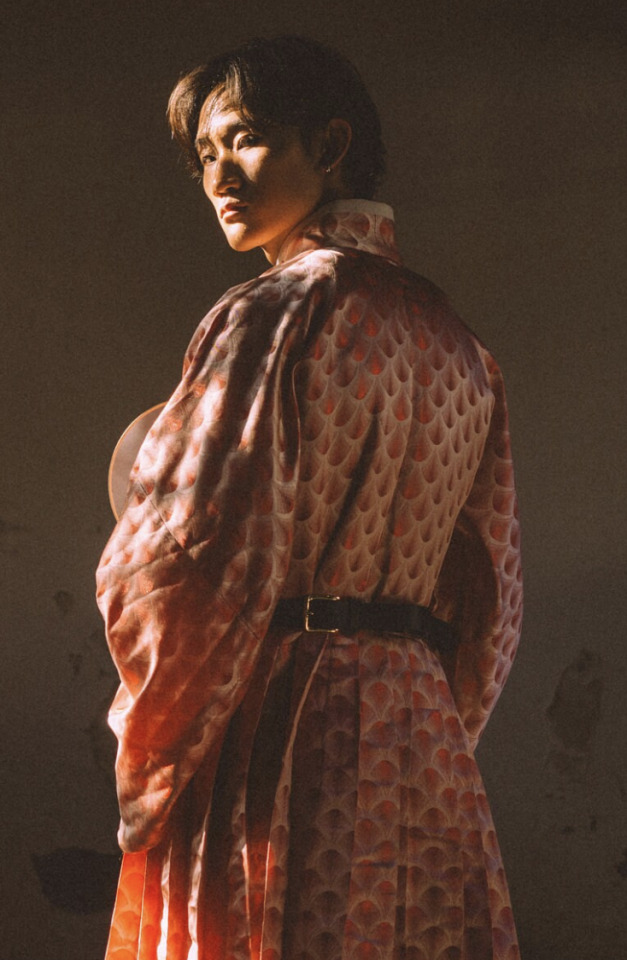
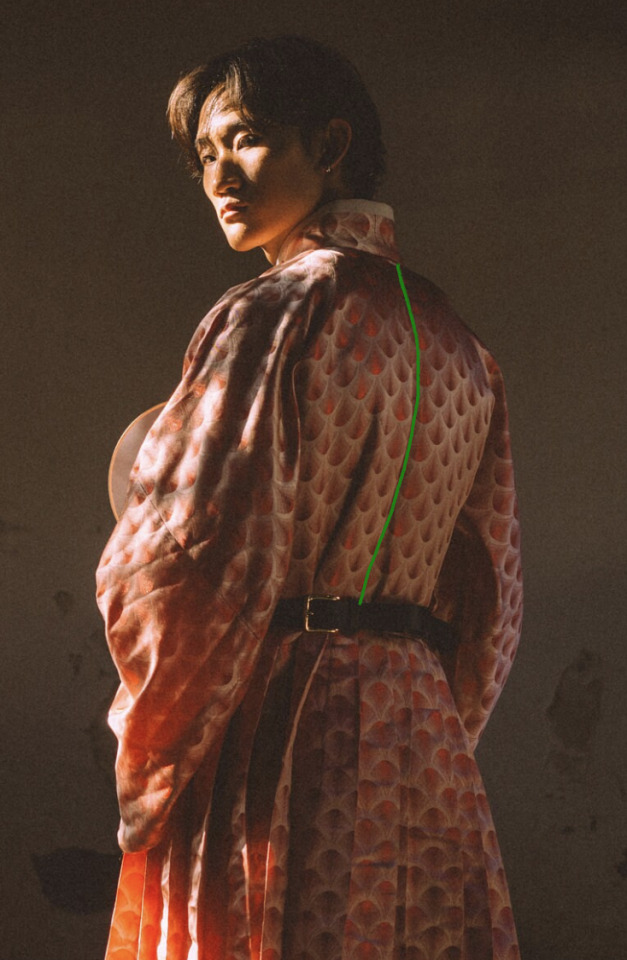
不破肩/不破肩/bu2 po4 jian1/No Broken Shoulder
Kind of an addendum onto the previous point? Additionally since the body pieces are separated into left/right rather front/back, there’s no seam at the top of the shoulder here. The fabric is simply draped over the arm/shoulder to hang down, covering the torso on both sides.*


*Caveat: Some modified hanfu that vendors sell today will have a shoulder seam, especially thicker winter garments or short-sleeved garments. This is a design choice made to prevent the fabric from looking too stiff, known as 破肩/破肩/po4 jian1,literally “broken shoulder.” It can look great, lots of hanfu makers do it! But just to be clear, that is a MODIFICATION.
接袖/接袖/jie1 xiu4/Sleeve Connection


Western clothing patterns tend to have something where the fabric of the sleeve gets connected to the fabric of the garment’s body at the shoulder/armpit, often with a concave arm hole shape to help with the contours of the garment when it’s worn.

Hanfu sleeves, on the other hand, are never connected at the armpit—they are connected halfway down the arm. In other words, the piece of fabric that forms the body extends to also cover the upper arm part of the sleeve. The actual sleeve piece is connected to the body at the bicep/elbow area via a flat seam. (In the case of half- or no- sleeve garments there might just not be a separate sleeve piece.)

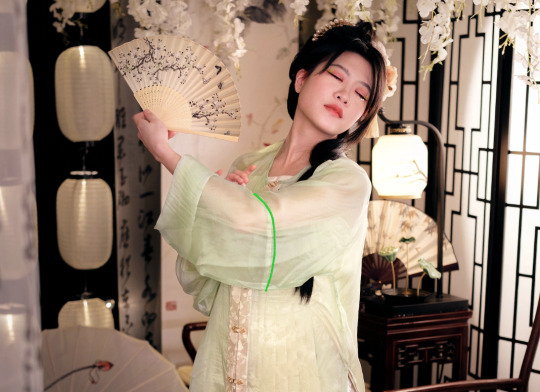
右衽/右衽/you4 ren4/"Right Over Left" Rule
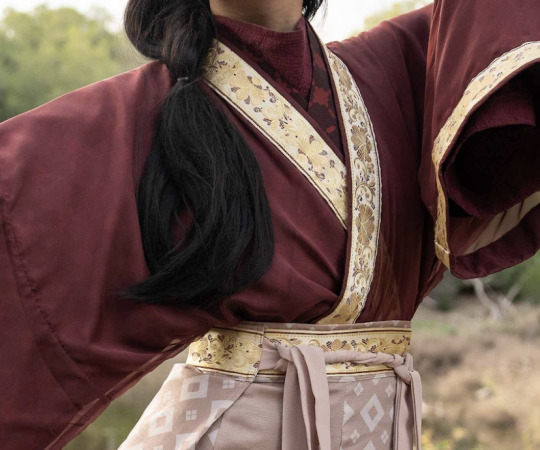

Applies to cross-collar, some varieties of round collar, and some varieties of standing collar tops. In the case that the front of the garment crosses over itself, the flap coming from the wearer’s left goes OVER the flap coming from the wearer’s right. Easiest way to make sense of this is, if you’re looking at someone wearing a cross-collar hanfu top, the cross will look like a lowercase y.


Caveats
NO RULE EXISTS WITHOUT EXCEPTION!!! These rules exist because a majority of hanfu follow them and they are a standard that people agree on right now. However, there are ALWAYS cases—historically or otherwise—where these rules may be broken. For example, there are several Ming Dynasty cross collar robes that happen to be left over right, and the location of the sleeve seam can differ based on what garment you're looking at.
Also, many modern hanfu manufacturers will deliberately choose to break these 'rules' in favor of aesthetics. This is a purposeful design choice—not one that's done out of ignorance or disrespect. It's easy for common modifications to get mistaken for 'historically accurate.' To be clear, it is 100% okay and super common for modifications to exist! Just don't go around claiming that it was historically that way.
My advice is that if you're starting out with hanfu, try to stick to these rules in the back of your head as closely as possible. Once you've built your foundational knowledge, then you can start exploring the exceptions to the rules. These rules may not be foolproof, but they are a useful tool to help you understand the commonalities and trends within hanfu without overwhelming you.
Last note: it is generally more of a taboo for seams that should exist to not exist in a piece of clothing (i.e. no center back seam) than for extra seams to exist. If you go look in museums for the artifacts that hanfu is based off of, you'll notice that a lot of them—especially the ones from earlier dynasties—are a chaotic patchwork of a bunch of random piece of fabric sewn together to create the garment. Fabric is expensive, people don't want to waste it! So it's not all that weird to have seams in random places.
Happy 除夕 everyone! 有蛇有得 :>
navigation: hanfu in components 1 2 3.1 3.2 4 5 6 ...
#hanfu#hanyuansu#terminology#once again idk how to tag#avoiding my homework#hanfu fashion#chinese fashion#chinese history#chinese language#im all alone on new years eve ;-;#my due dates are keeping me company its ok#shitty drawings by tangtang#chinese hanfu#fashion#hanfu photoshoot#hanfu art#cloud9hanfu#cloud9 hanfu#九雲閣#hanfu in components
314 notes
·
View notes
Text
Sternberg's Triangular Theory of Love + Stranger Things Couples
This is very different from my other posts on here, but I was inspired by @hawkinsschoolcounselor to make this. Just wanted to give this tag some of my own insight from a Psychology student's perspective, specifically talking about the Triangular Theory of Love (TTL) in relation to couples (whether they are platonic or romantic or not) on Stranger Things. I'm not here to say that the Duffer Brothers specifically took inspiration for their couples from this theoretical model, just that this is one of the many theoretical models of relationships that can be applied to how people view love. Therefore, a writer would have written real life people's experiences of love into the show.
(Just want to quickly add -- this theory was made in the 80s. The most common criticism of this model is that it is made on the basis of westernised ideals of love. It also does not take asexuality or aromanticism into account.)
First of all, an Introduction to the TTL:
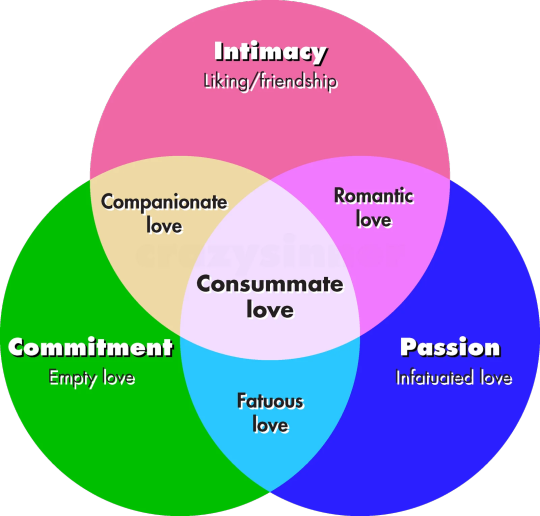
Imagine yourself a triangle. Every triangle has three sides. Each side of this triangle is an essential component to love. It’s the combination of these elements that creates the different types of love we experience.
First, we have Intimacy, which isn't your classic physical intimacy that you know (e.g. hugging, kissing). It's basically the emotional side of love. Can you tell this person your deepest secrets? Can you trust them? Do you two have similar interests? Can you have a laugh? Intimacy is what makes us feel understood and accepted for who we are.
Next, is Passion, which is the fire, the spark, the physical attraction that ignites the magnetic pull between two people. The chemistry, the electricity, you could say. We feel this at the beginning of most relationships, that intense desire to be with someone, emotionally and physically.
Lastly is Commitment. This is the decision to stay, to continue even if something changes. This can be for various reasons like investments you've made in the relationship, the promises you've made to someone.
Each of these components are associated with a certain type of love.
Nonlove -- This relationship has neither intimacy, commitment, or passion. You are acquaintances with this person.
Liking -- This relationship has intimacy only. This is a friendship, without commitment or passion that a romantic relationship has.
Infatuation -- Only has passion. It's exciting, overwhelming, but there's no emotional connection, trust, or commitment.
Empty -- Only has commitment. The relationship is stable and safe, but has no real connection or passion that it may once have had or never had.
Companionate -- This relationship his intimacy and commitment, but it does not have passion. This could be a very close friend, or a couple that may be in love but do not have physical attraction to one another.
Romantic -- You are intimate with this person and have passion with them, but you are not yet committed. For example, a partner that you've been dating for a short time.
Fatuous -- The presence of passion and commitment, but without intimacy. For example, two people who barely know each other can get married super quick on a whim.
Consummate -- Is the 'ideal' love. This is the complete, balanced love we all strive for. It’s a mix of deep emotional connection, physical attraction, and a strong, lasting commitment.
So how does this relate to Stranger Things?
I do believe we can sort of apply these definitions of love to many different duos in ST, and see what this means for them in the future. Love can also be different on either side, for example, on side of the duo may see passion in their love, while the other side sees none.
BTW you may notice that I'm not going to include Byler or Mileven in this first list, I will diagnose them after all the other duos in the show. So scroll down if you want to only see them.
Nonlove
This would be a duo from ST that really has no interaction with each other. No commitment, no emotional connection, no physical connection. I guess we can just pick people who've barely had an interaction, like Steve and Will. Eddie and Hopper. Mike and Robin (not yet anyways).
Liking
E.g. Joyce and Murray, Mike and Lucas. Just friends, but they are friends enough that they have believable closeness and an understanding of one another. More examples include all the party's friendships with each other (except Mike and Will). I don't want to really dumb them down into not being committed toward each other, but we can see that they're not dependent on each other in a way that's got more emotional depth than some other platonic duos in the show.
Infatuation

The only notable one that I can think of here is Stancy, more specifically on Nancy's side. This means she only has passion with him, aka, physical attraction. She's not intimate with him (in this model's definition at least). This model's definition of intimate means sharing deep secrets and trusting each other. During S1, Nancy's reason for being with Steve was because he was popular and she was just excited to be with the most desire guy in high school. She didn't confide in him about her emotional turmoil, she didn't understand his decisions and he didn't understand hers. In S2, this is the same. The only time that she confronted him was when she was drunk, other times she didn't feel he understood her enough like Jonathan did.
She also wasn't committed to him, which makes sense, because she had a far more emotional intimacy with Jonathan.
Empty

The first one that comes to mind ^. Obviously, this isn't necessarily fully in line with the psychological definition of 'Empty love', because Karen is not fully committed to Ted in S2 or S3, but ultimately she does make the decision not to cheat on her husband because of her commitment to her family. They have no intimacy and no passion (Ted's bed is literally downstairs). This is one of those relationships where people don't even have to ask why they don't get a divorce -- because they're too committed, which is their downfall.
Companionate

I believe Steve and Robin are different to those friendships in the 'Liking' category. They have intimacy, because they confide in each other and understand each other on a deeper level. But they're also committed to each other in a way that the other platonic duos don't have. They go where the other goes -- (they always need to have the same job together), and other people already think they are a couple (based on heteronormativity but also because they're seen together so often). They obviously have no passion, because uh well, their physical attractions lie elsewhere.
Romantic
I couldn't think of anything that just fitted only intimacy and passion and no commitment, most of the couples on ST basically have commitment if they also have the other two.
Fatuous
Without intimacy, but only commitment and passion, this is a super rare kind of love, and probably not represented in Stranger Things. If anyone has any idea of what could be in this section, please let me know.
Consummate
The ideal love, with intimacy, passion and commitment, is luckily represented by most of the canon couples in Stranger Things. This is how you know that the writers are good at writing believable romances -- you don't need the characters to explicitly state that they are in love for you to know, because they have all three of the staples for an ideal love.
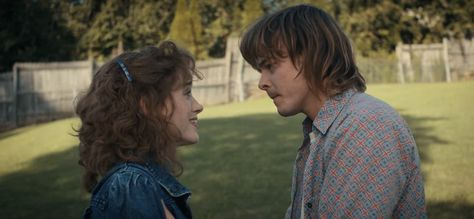
Jancy has intimacy because they can tell each other secrets and they understand each other's emotional traumas (Jonathan understands Nancy's trauma surrounding Barb, for example. As a wise man once said, they have shared trauma). The biggest reason why they definitely have this love to me, though, is because the moments that they have the most trouble in their relationship is when one of these sections breaks down. AKA -- intimacy was broken down in S3 when they 'don't understand each other' anymore, and they were able to come back from this, showing their commitment. Season 4 also shows their commitment, because while Nancy was being sweet talked to by Steve (ugh sorry), she still stayed committed to Jonathan, same on Jonathan's side. Despite being in a different state, he still made all his decisions based on her future as well as his, showing they were committed.
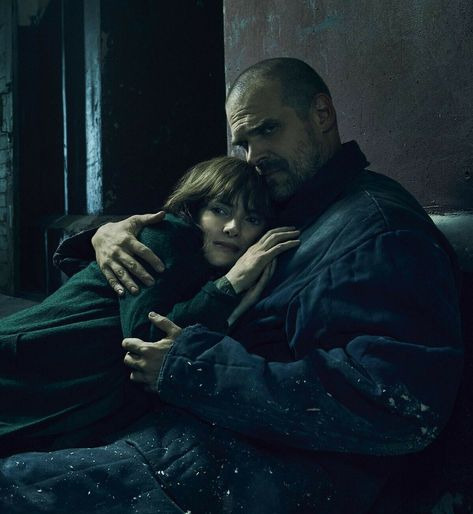
Jopper has intimacy because she feels that he understands her more than anyone -- he met her in high school and clearly have both shared memories and shared trauma. They trust each other with sensitive information about each other's lives, and are able to confide in each other when the other is going through something. The commitment is shown deeply in Season 4. Joyce's commitment is quite literally shown in almost crashing in a plane for him and trying to break him out of prison. Hopper's is the plan he makes to break out and go see her. Their passion well.... that is also shown in the way Hopper continues to pine for her in S3, giving her longing looks, but also in S4 because this desire has a pay off.
Okay so now we can talk about which categories Mileven and Byler fit into:
Mileven and Byler
Lets' start by looking at each of the three components:
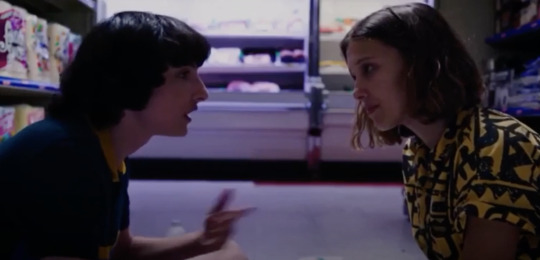
Mileven's Intimacy: In the beginning of Season 1, Mike has emotional understanding with El, but this is gone by the time Season 4 rolls around. She explicitly states to him "No. You don't." He also finds no time to express his insecurities about his relationship with her actually with her, instead choosing to confide in Will about his insecurities. On El's side, she chooses to lie to Mike about having a really hard time in California, because she does not have the intimacy with him to feel like she can confide in him. There is a reason for this, obviously, and that is because she feels insecure about their relationship. But instead of communicating that, she chooses to ignore it. When Mike finally chooses to tell El about his 'feelings', even if they are true, he is only spurred on by Will alone, not by his own desire to do it. Whenever Mike tries to actually tell El what he's feeling, he ends up trying to do it in other ways in order to avoid it. Their scenes where they're about to open up to each other are either interrupted or extremely frustrating.

Byler's Intimacy: Will has always chosen Mike to talk about his problems with. He says to him in the 'crazy together' scene that Mike can't tell the others because they won't understand, showing that they have a unique kind of intimacy. Will also chooses to confide only with Mike about his problem with D'art in S2, because the situation is slightly icky (because D'art was literally inside him ig) and trusts only Mike with this situation. This is the same as the situation at the end of S4, where Will knows it would be scary for anyone else to hear, but he's happy to tell Mike about Vecna being alive. Luckily, Mike is ready to jump into action at the drop of a hat in both situations. Mike's intimacy with Will is the sheer amount of heart-to-heart scenes they have in S4. He's always ready to tell Will about his relationship problems, but not El (and no, not just because she's in the lab). He's more comfortable around him than El. All Mike and El do is make out (in S3), have some slight banter, but they don't actually have any shared interests. Mike and Will both have the shared interest of all things nerdy, and Mike finds Will's artwork moving and amazing. Mike has been shown to have an appreciation for what Will creates.
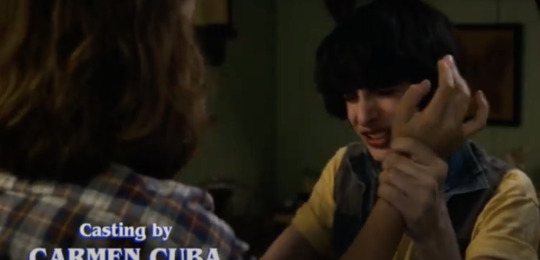
Mileven's Passion: I guess it's slightly awkward to talk about this kind of stuff with either Mileven or Byler, because they are teenagers. But teenagers obviously experience physical attraction and desire. The reason we can see this desire in other couples is because they have a lot of build up. Jancy have desire because they've been kept from each other because of Steve and Nancy being together. Jopper have been kept from each other because of Joyce's relationship with Bob and her grief, then Hopper being kept in jail (though that's not to do with romance). Lumax have been kept from one another because of Max refusing to get help from others. There was no pining, desiring moment with Mileven. And I know what people might say: Season 2 and Season 3 had moments where they were kept from each other and it was shown that Mike wanted her back. Oh? You mean the Mike that gave up on calling her and focused on Will until El reappeared again? You mean the Mike that joked around with Lucas after El broke up with him and played himself as the victim? It's not the same, because it has no pay off like the others. The maybe-pay off is the 'passion' of them making out in S3, constantly getting interrupted by some funny old guy haha!. As Hopper said, too much passion is 'not normal, not healthy'. This passion has Mike pulling her hands away from him and is just presented as humour/puberty-ridden teens figuring themselves out. Idk man

Byler's Passion: Ignoring the fact I feel so weird talking about this, let's just reiterate some of the points I brought up to you in the last paragraph. All other main couples in ST have had a moment of unambiguous pining. Jopper, Jancy and Lumax. This is also the case with Byler, clearly, from S4, Will's pining for Mike can be seen as him wanting something. Have you seen those longing looks, marked by sweet, pining music? Those scream attraction, even though some of you might be allergic to two teen boys showing attraction to each other but are totally fine with 13 year olds making out. Those are just Will's pining moments. I mean, I can talk at length about Mike's slip ups. The triple take? The amount of lip glances on this man? It's hard to say at the moment whether they have passion in this relationship, but the thing is. We don't need to have it right now. All we need to know is that there is potential for it, potential for an amazing pay off where Will confesses his feelings. And from the amount of pining Will's shown (and Mike in a lot of ways), there definitely is potential.
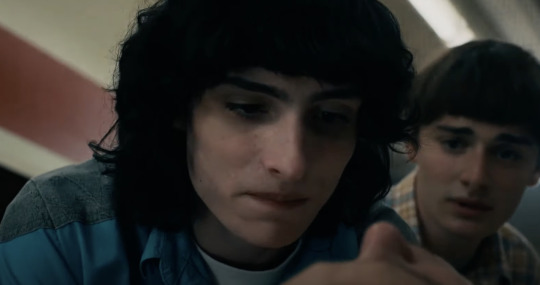
Mileven's commitment: So this is where they actually have something. But that's not necessarily a good thing. Mike is the first person that treats El well after being stuck in an abusive lab for the first 12 years of her life. He made a promise to her that he would take care of her, and they both stress that Friends Don't Lie. They don't want to lose each other. Mike tells Will and El that he doesn't want to lose her and wants her to need him. This is not the same as romantically loving somebody. Mike's feelings shift during S2 and S4, but his commitment to El overrides everything. El wants to break up with him because of various reasons, and says that he is her 'first boyfriend' during S3. But they still stay together despite the troubles in their relationship, showing that the commitment is not something they want but something they need in order to feel secure. We have established they have no intimacy, we have established they have no passion. So why do they stay together? Because of the security, or some other reason. We have seen that Mike doesn't love El during S4 because he describes 'explaining himself' to her, while also not knowing what to say when she spells it out for him. We have seen how Mike treats El poorly, and the other way around. They lie to each other, they don't confide in the other. But they stay together because... they've made a promise, a commitment. Mike says I love you because she's going to die and believes it's what she wants. Even if this commitment was supposed to be genuine and pure, it can't be worth rooting for without intimacy and passion.
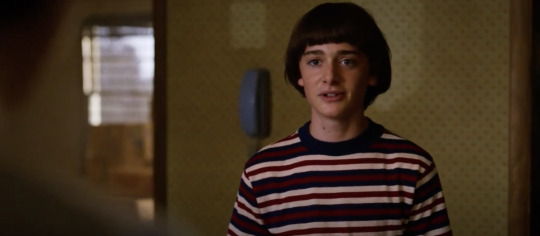
Byler's commitment: Will states many times that he will always be Mike's friend, always need him, wants to be with him for the rest of his life, playing games in his basement. That is the most obvious sign of commitment I have ever seen. He is so committed that he is willing to sacrifice his own feelings in order to make Mike happy, effectively tying himself to his love forever. Mike is committed to Will in his own way. He is always the one to apologise and take the fall in their arguments, while with El he is not committed in that way. When Will is away from Mike, he's worried that he's lost him. Basically this means Mike is afraid that Will isn't as committed as he is to their friendship. It's funny because Will has the exact same worries during the Rink o Mania fight. But that's the irony. They are both committed. Mike's commitment despite the distance is shown through his fear of losing Will. Will's commitment to him despite the distance is through his painting. No matter what, Mike is always ready to be a team with Will and work with him. Even while they were supposed to be fighting, Mike confides in Will. And Will? A huge part of Will's arc is his undying commitment towards Mike, which makes his scenes with Mileven so upsetting -- because we know his love will never end, meaning his sadness won't end unless Mileven break up.
So what's the diagnosis?
Mileven: Empty Love (Only commitment to each other. There is no show of emotional understanding and connection. The passion and pining for each other is not shown like with other ST couples.)
Byler: Consummate Love (Has all three elements. Both have a mutual understanding to each other's needs, both have a mutual pining, even though it's much easier to see on Will's side. Both have a commitment to the other in their own way. All other popular ST couples have this love and would fit in with Byler's)
Im so scared to post this because it's so different from my other posts. But hopefully you see that even if Byler is not endgame, Mileven being endgame would not be a true show of 'love defeats all' -- because it is not a healthy love.
#byler#byler nation#byler endgame#mike wheeler#will byers#stranger things#byler evidence#byler proof
203 notes
·
View notes
Text
You don't like Wenclair? Absolutely OK, that's all very well, but to call it forced is just a big mistake and I will explain why (the artist of the fan art on Percy and Annabeth is Sethkiel, Tumblr, Twitter and Instagram) + Percy Jackson spoilers about his romantic relationship in the books

Enid is in effect an ideal choice as a partner for Wednesday Addams not only because of their obvious character complementarity, but also because of the positive impact a relationship based on their dynamic could have on both personalities.
Various psychological and social studies support the idea that interpersonal relationships based on complementarity and mutual acceptance are more likely to be healthy and long-lasting. Wednesday, with her introverted, cynical and distant character, is balanced by Enid, who stands out for her emotional openness, empathy and desire to connect with others.
This polarity creates a synergy that not only enriches their friendship but could serve as the basis for a meaningful romantic relationship.
One of the key components is the unconditional support Enid offers Wednesday. According to research on the psychology of relationships, emotional support is one of the strongest indicators of relationship satisfaction.
Enid, despite the difficulties Wednesday poses to her, constantly stands by her side, demonstrating a patience and understanding that goes beyond mere friendship.
This type of dynamic is consistent with the findings of Feeney and Collins (2015), who highlight how relationships characterised by a partner who serves as a ‘secure base’ improve resilience and psychological well-being for both parties. For Wednesday, who often shows difficulties in trusting others and expressing her emotions, having a figure like Enid beside her could help her explore deeper aspects of her emotional identity.
Moreover, Enid represents a form of positivity and optimism that counterbalances Wednesday's cynicism. This counterbalance, far from being a hindrance, proves beneficial. Studies conducted by Gable et al. (2006) suggest that relationships in which one partner promotes positive emotions and encourages the other to experience joy and pleasure have a positive impact not only on individual well-being, but also on couple cohesion. Enid's ability to celebrate life's simple moments and accept Wednesday as it is can offer her a safe space in which to lower her defences without feeling judged.

The chance of a queer relationship between Wednesday Addams and Enid Sinclair is not only coherent with the long history of the Addams Family, but also represents a natural evolution of Wednesday's character.
The Addams Family, since its creation, has been a symbol of rebellion against social norms and celebration of difference.
Charles Addams conceived the family as a parody of traditional American families, overturning their conventional values.
While middle-class American families aspired to normality, the Addams family found pride and beauty in their eccentricity. This attitude made the family an icon for anyone who felt marginalized or different, including queer communities. Their gothic aesthetic, black humour and unqualified acceptance of all forms of strangeness made them symbols of inclusivity, even if this theme was rarely made explicit directly.
Wednesday Addams, in particular, embodies this challenge to social projections. From her earliest appearances, she has been portrayed as an intelligent, sarcastic and deeply independent outsider who rejects imposed social norms. In the films of the 1990s, this nature is clearly expressed: Wednesday, despite being young, is perfectly aware of her identity and interests, refusing any attempt to force her to conform.
An emblematic example is her relationship with Joel Glicker in The Addams Family 2.
Joel, an insecure and nerdy boy, becomes an ally and romantic interest, but the relationship is clearly devoid of the traditional dynamics of teenage romance.

Wednesday shows interest, but expresses it in his own way, with humour and detachment. This episode shows that Wednesday is not ‘immune’ to romance, but lives it according to her own rules.
In the Netflix series Wednesday, the dynamic with Enid Sinclair adds an even greater level of complexity. Enid, with her sunny disposition and expansive nature, is the perfect counterbalance to Wednesday's coldness.
Their relationship is built on a foundation of trust, emotional intimacy and mutual support that far surpasses any other connection Wednesday develops in the series, including those with her male romantic interests, Tyler and Xavier. Psychological studies, such as that of Aron et al. (1997) on interpersonal intimacy, show that the strongest relationships are often based on complementary differences. Wednesday and Enid embody this complementarity: the dark and the light, the rational and the emotional, detachment and empathy.
This kind of dynamic is often the basis of the most memorable romantic relationships in fiction, and it would be only natural for their bond to evolve into something more.
The criticism that a queer relationship between Wednesday and Enid would be a ‘stretch’ often masks prejudices about queer inclusivity. Interestingly, audiences unreservedly accept heterosexual romance in contexts that do not always align perfectly with the characters' personalities.
For instance, in the 1990s films, no one criticised the fact that Wednesday, a deeply cynical and aloof girl, had a romantic moment with Joel. Similarly, in the Netflix series, her interactions with Tyler and Xavier are accepted without particular objection, despite the fact that Wednesday shows very little genuine interest in either of them.
This demonstrates a double standard: heterosexual romance is perceived as ‘natural’ and acceptable, while queer romance must be justified or considered as extraordinary.
Queer representation in the media, as studies by GLAAD (2022) show, is crucial in normalising these relationships and offering positive role models for those who identify outside traditional norms. The relationship between Wednesday and Enid would not only be consistent with the characters, but also an important step towards greater inclusivity. Furthermore, the argument that Wednesday ‘is not made for romance’ is easily disproved by her narrative history. She has never been a traditionally romantic character, but that does not mean she cannot develop genuine and deep connections.
Her emotional openness towards Enid in the series is a clear sign of personal growth and openness towards meaningful relationships.
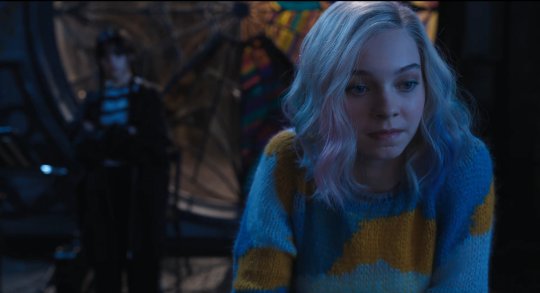
Finally, it is important to point out that many of the most famous romantic relationships in fiction were born out of deep friendships. From Harry Potter (Ron and Hermione) to Friends (Ross and Rachel), the transition from friendship to romance is a widely accepted narrative trope, especially when it involves heterosexual couples. It is hypocritical to consider it a stretch only in the case of queer relationships. In the case of Wednesday and Enid, their emotional intimacy and mutual support lay a solid foundation for a romantic relationship that would not only be consistent with the Addams Family's history, but would also represent a natural evolution of Wednesday's character, keeping her rebellious and non-conformist essence intact.
Let's take a concrete example to show that the basis of the Wenclair ship is valid?
Percy Jackson.
The relationship between Percy Jackson and Annabeth Chase is built in a gradual way and represents a story arc that starts with friendship and grows into romance, making it a perfect example to show that it is not ‘forced’ when a close bond turns into love.
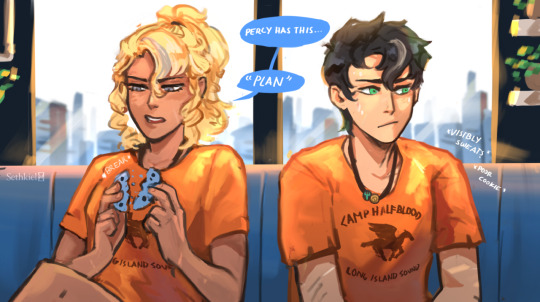
The saga of Percy Jackson and the Gods of Olympus offers an excellent example of how a friendship can develop naturally into a romantic relationship. The dynamic between Percy Jackson and Annabeth Chase develops gradually, reflecting a relationship-building model that emphasises mutual growth, respect and trust. Initially, Percy and Annabeth meet in the context of Camp Half-Blood, where significant differences in their characters emerge. Annabeth, rational and strategic, tends to see Percy as an unprepared novice, while Percy perceives Annabeth as distant and authoritarian. Nevertheless, their shared adventures lead to a mutual respect that becomes the basis for a solid friendship.
In later books, such as The Sea of Monsters and The Titan's Curse, their relationship deepens through moments of vulnerability and emotional connection. Annabeth shares with Percy her ambitions and fears, such as the dream of building something lasting or the burden of her loyalty to the gods. Percy, for his part, shows a growing sense of protection towards Annabeth, being willing to risk his life to save her on several occasions. These episodes mark a gradual evolution of their relationship, but without ever abandoning the friendly core that sustains it.
The turning point occurs in the fourth book of the saga, The Battle of the Labyrinth, when Percy begins to acknowledge his romantic feelings for Annabeth. However, the transition does not happen abruptly; both characters, being still teenagers, navigate uncertainly between friendship and love, making their relational development realistic and free of narrative forcing. In later books, such as The Final Clash and especially in the Heroes of Olympus series, Percy and Annabeth consolidate their romantic relationship without ever losing the bond of friendship that characterises them. This balance is particularly evident in The House of Hades, where their mutual support, even in extreme situations, underlines the depth of their bond.
The transition between friendship and love in the case of Percy and Annabeth is an example of a well-constructed narrative, reflecting real dynamics also highlighted by psychological studies. According to Kaplan and Keys (1997), many successful romantic relationships develop from pre-existing friendships due to the presence of trust and emotional intimacy as solid foundations. Moreover, this dynamic is widely accepted by the public, as it reflects common human experiences. The story of Percy and Annabeth demonstrates that the transition from friendship to romance can be organic and believable, especially when constructed with attention to the emotional aspects of the characters.
Applying this perspective to the case of Wednesday and Enid, it becomes clear that such a transition would not be ‘forced’, as is often claimed by some critics. The two girls share a relationship that is based on complementarity and mutual growth: Wednesday is cynical and reserved, while Enid is expansive and empathetic, and together they create a balance similar to that between Percy and Annabeth.
To ignore this possibility is to operate a double standard, considering acceptable for heterosexual couples a dynamic that is labelled as unnatural or artificial in the case of a queer couple. The representation of Wednesday and Enid in a romantic relationship would not only be consistent with traditional narrative dynamics, but could also contribute to greater inclusivity and a richer, more nuanced representation of relationships in pop culture.
#wenclair#wednesday addams#wednesday#enid sinclair#netflix#netflix wednesday#jenna ortega#emma myers#wenclair endgame#wenclair novelisation
220 notes
·
View notes
Note
hi there! im a fan of your page 💕
can you give me the best studying techniques?
hi angel!! @mythicalmarion tysm for asking about study techniques 🤍 i'm so excited to share my secret methods that helped me maintain perfect grades while still having a dreamy lifestyle + time for self-care!! and thank you for being a fan of my blog, it means everything to me. <3
~ ♡ my non-basic study secrets that actually work ♡ ~
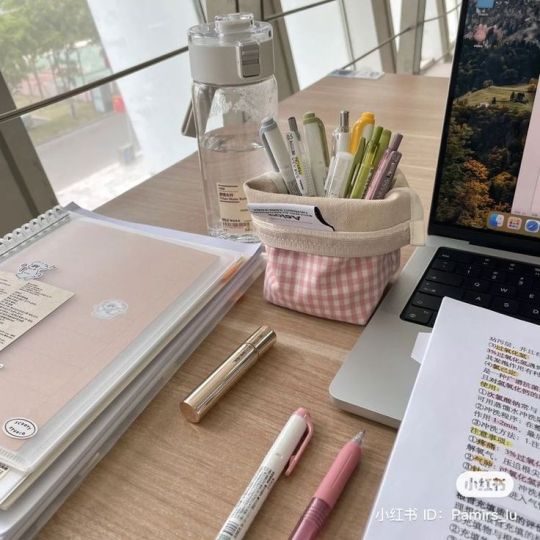



(don't mind the number formatting)
the neural bridging technique this is literally my favorite discovery!! instead of traditional note-taking, i create what i call "neural bridges" between different subjects. for example, when studying both literature + history, i connect historical events with the literature written during that time. i use a special notebook divided into sections where each page has two columns - one for each subject. the connections help you understand both subjects deeper + create stronger memory patterns!!
here's how i do it:
example:
left column: historical event
right column: literary connection
middle: draw connecting lines + add small insights
bottom: write how they influenced each other
the shadow expert method this changed everything for me!! i pretend i'm going to be interviewed as an expert on the topic i'm studying. i create potential interview questions + prepare detailed answers. but here's the twist - i record myself answering these questions in three different ways:
basic explanation (like i'm talking to a friend)
detailed analysis (like i'm teaching a class)
complex discussion (like i'm at a conference)
this forces you to understand the topic from multiple angles + helps you explain concepts in different ways!!
the reverse engineering study system instead of starting with the basics, i begin with the most complex example i can find and work backwards to understand the fundamentals. for example, in calculus, i start with a complicated equation + break it down into smaller parts until i reach the basic concepts.
my process looks like:
find the hardest example in the textbook
list every concept needed to understand it
create a concept map working backwards
study each component separately
rebuild the complex example step by step
the sensory anchoring technique this is seriously game-changing!! i associate different types of information with specific sensory experiences:
theoretical concepts - study while standing
factual information - sitting at my desk
problem-solving - walking slowly
memorization - gentle swaying
review - lying down
your body literally creates muscle memory associated with different types of learning!!
the metacognition mapping strategy i created this method where i track my understanding using what i call "clarity scores":
level 1: can recognize it
level 2: can explain it simply
level 3: can teach it
level 4: can apply it to new situations
level 5: can connect it to other topics
i keep a spreadsheet tracking my clarity levels for each topic + focus my study time on moving everything to level 5!!
the information architecture method instead of linear notes, i create what i call "knowledge buildings":
foundation: basic principles
first floor: key concepts
second floor: applications
top floor: advanced ideas
roof: real-world connections
each "floor" must be solid before moving up + i review from top to bottom weekly!!
the cognitive stamina training this is my absolute secret weapon!! i use a special interval system based on brain wave patterns:
32 minutes of focused study
8 minutes of active recall
16 minutes of teaching the material to my plushies
4 minutes of complete rest
the specific timing helps maintain peak mental performance + prevents study fatigue!!
the synthesis spiral evolution this method literally transformed how i retain information:
create main concept spirals
add branch spirals for subtopics
connect related concepts with colored lines
review by tracing the spiral paths
add new connections each study session
your notes evolve into a beautiful web of knowledge that grows with your understanding!!
these methods might seem different from typical study advice, but they're based on how our brains actually process + store information!! i developed these through lots of research + personal experimentation, and they've helped me maintain perfect grades while still having time for self-care, hobbies + fun!!
sending you the biggest hug + all my good study vibes!! remember that effective studying is about working with your brain, not against it <3
p.s. if you try any of these methods, please let me know how they work for you!! i love hearing about your study journeys!!
xoxo, mindy 🤍
glowettee hotline is still open, drop your dilemmas before the next advice post 💌: https://bit.ly/glowetteehotline

#study techniques#academic success#unconventional study methods#creative study tips#neural bridging#shadow expert method#reverse engineering study#sensory anchoring#effective studying#minimal study guide#glowettee#mindy#alternative learning#academic hacks#study inspiration#cognitive stamina#learning tips#study motivation#unique study strategies#self improvement#it girl energy#study tips#pink#becoming that girl#that girl#girlblogger#girl blogger#dream girl#studying#studyspo
175 notes
·
View notes
Text
Writing Notes for your Sex Scenes

Sex - a physical bonding activity that can be an important part of many types of relationships—including monogamous, polyamorous, and open partnerships—because it can offer increased emotional intimacy, a stronger self-image for each partner, and stress relief.
Avoid looking for a one-size-fits-all solution to sex in a relationship; you can have a strong, healthy relationship regardless of the amount of sexual activity.
While many people require frequent sexual activity for a strong romantic relationship, many others—including asexual individuals and those with low libidos—enjoy deep and meaningful partnerships without using sex as a key component.
Benefits of Sex for a Relationship
In relationships in which each partner feels sexual desire and wants to be sexually active, a healthy sex life can offer significant benefits, including:
A stronger self-image: Sexual activity is a physical act that emphasizes the pleasure your body can give and receive; mindful, regular sex can increase confidence, self-esteem, and body positivity for each partner, allowing you to carry these feelings into other areas of your life.
Increased intimacy: Sexual activity is a type of physical intimacy that releases the hormone oxytocin, which produces feelings of emotional connection and intimacy. Therefore, sex can deepen the bonds between partners and foster feelings of closeness, emotional well-being, and relationship satisfaction.
Stress relief: Good sex is a stress-relieving activity that releases endorphins, producing feelings of relaxation and satisfaction that can help melt away the stresses of a difficult day. In the same way, sexual satisfaction and orgasm can help foster better sleep.
Talking About Sex With Your Partner (or Partners)
Communication about sexual intimacy is vital in any healthy sexual relationship because it allows each participant to build a connection that is more in tune with each partner’s desires and comfort zones. Here are a few tips to help you talk to your partners about sex:
Avoid critical statements. It’s normal for sexual partners to be sensitive when talking about intimacy (especially if it’s your first time communicating like this), so be as kind and positive as possible. Rather than saying, “I wish we had more oral sex,” try a more encouraging phrasing like “I love it when you go down on me—it would turn me on a lot if you did it even more.” Avoid phrasing that could sound accusatory; where possible, frame your comments as “I-statements” or “we-statements.” For example, try “I would love it if we tried…” or “Would it be fun if we tried…” rather than “you-statements” like “You should…” or “What if you tried…” to shift the focus and tone.
Avoid focusing on sexual frequency. You can have a good sex life regardless of the amount of sex you engage in; it’s about staying in tune with each partner’s interests and sexual desires. This may mean less sex but higher-quality sex, or it may mean planning masturbation sessions when one partner isn’t feeling in the mood. When you talk about sex with your partner or partners, keep in mind that the goal is mutual wellness rather than more sex.
Be open and honest. Talking openly and truthfully is essential for a healthy sexual conversation. The information you share helps your partner or partners improve their understanding of your sexual preferences and encourages them to share their desires honestly. Being up-front and honest about your feelings around sex will create a safe space for you to develop your sexual relationship together; the best sex is sex that is collaborative and trusting.
Choose a calm and comforting moment. Sex can be a difficult and sensitive subject for many people, so ensure conversations about sex happen in spaces that feel safe and relaxed. Avoid initiating the conversation during or immediately after a difficult moment; instead, try talking during a relaxed cuddling session or in a room other than the bedroom. This creates a safer, less charged space for open discussion.
Discuss libido and interest. Sex is only a beneficial part of a relationship if each partner wants it. If you find that your partner seems less interested in sex than you are, sit down and have an honest conversation with them. Ask if there are things in their life that seem to get in the way of their sex drive, if there is a type of sex they’re interested in that you haven’t explored together yet, or if they have a major sexual turnoff they haven’t shared yet. Investigate the other areas of the relationship you could improve together to work toward a healthier sex life.
Involve a sex therapist. If you or your partner or partners struggle to communicate about your sexual relationship or insecurities, consider consulting a sexual health professional to help facilitate the conversation and help you work toward a healthier bond and better sex.
Source ⚜ More: Notes ⚜ Writing Resources PDFs ⚜ "Beautiful" Words ⚜ Part 1 2
#requested#love#relationship#character development#writing notes#writeblr#literature#writing inspiration#character building#writing ideas#light academia#writers on tumblr#writing reference#spilled ink#dark academia#writing prompt#creative writing#konstantin somov#writing resources
176 notes
·
View notes
Text
Snow Moon - February 2025

Boots and mittens on, witches - it’s time for the Snow Moon!
Snow Moon
The Snow Moon is the name given to the full moon which occurs during the month of February. Despite what certain groundhogs will tell you, February is the month that sees the highest rates of snowfall across much of North America, according to the National Weather Service, and many alternative names for the moon and the month in which it falls reflect this.
As with many full moon names, we find the roots of the Snow Moon among the indigenous peoples of North America. In this particular case, a colonist explorer noted in 1760 that the Naudowessie (Dakota) people called this month Snow Moon specifically due to the tendency for snowstorms to come during that month. Some other indigenous names for this moon and month refer to commonly-sighted animals. Some examples include Eagle Moon (Cree), Bear Moon (Ojibwe), Groundhog Moon (Algonquin), and Goose Moon (Haida). Another notable example is Hungry Moon (Cherokee), denoting the scarcity of available food in deep winter.
The moon will be at peak illumination at 8:53am EST on Wednesday, February 12th. It will be below the horizon at this time, meaning the moon may appear to be full on the 11th and the 12th, depending on where you live. It should be highest in the sky around midnight EST on the 12th - the perfect time for magic!
What Does It Mean For Witches?
February is a month of change and transition. Though winter still holds on, many places may be showing early signs of spring. Little buds may be coming out on the trees, certain species of birds are beginning to migrate back, and hibernating animals start to wake up and reappear.
As we begin to turn toward the end of our long winter’s rest, it’s a good time to think about how we prepare for oncoming change and how we care for ourselves and our practices during times of stagnation.
We might also contemplate the concept of distance and stasis as it relates to our practices, be it keeping long-distance bonds fresh, doing things remotely either alone or as part of a larger group, or feeling distant from your craft or your deities. And yes, such things are normal and cyclical. Our inspiration and motivation wax and wane just as the moon does. If it feels like you’ve been far away from your craft for too long, perhaps it’s time to bring it back into your orbit.
What Witchy Things Can We Do?
Gather fresh snow or icicles for moon water, or make your own moon ice by leaving a bowl of water out overnight to freeze, if the temperature drops low enough.
If it snows in your area, you can wish upon a snowball. Grab a handful of powdery snow, whisper your wish to it, and throw the whole thing up in the air to release the wish into the universe
With winter scarcity in mind, practice creating a minimalist spell as an exercise. Create a workable spell with as few components, words, movements, or ritual elements as possible. This is more of a challenge if you’re used to using material components or rituals in your spellwork. Many witches cast spells with focused thought or energy work alone.
You can also try creating a spell with only components and materials that you already have on hand. Explore your home and see how many items you can identify a magical purpose for and brainstorm different ways they could be used in your craft.
Explore the concept of self care as magic. Use your routines to create moments of rest and harmony, make a point of being kind to your body and your mind, and cultivate a more positive relationship with yourself - it’s the only one guaranteed to last a lifetime.
Connect with your local biome by looking for any early signs of spring in your area. Feed the returning birds and identify the plant and animal species you see around you as they appear one by one.
Happy Snow Moon, witches! 🌕❄️
SOURCES & FURTHER READING:
Bree’s Lunar Calendar Series
Bree’s Secular Celebrations Series
Snow Moon: Full Moon in February 2025, The Old Farmer’s Almanac.
Snow Moon: The Extraordinary Full Moon of February 2025, The Peculiar Brunette.
Witchcraft Exercise - Home Brews, Bree NicGarran. (Masterlist here)
Moon Info - Full Moon Dates for 2025
Calendar-12 - 2025 Moon Phases
Everyday Moon Magic: Spells & Rituals for Abundant Living, Dorothy Morrison, Llewellyn Publications, 2004.
(If you’re enjoying my content, please feel free to drop a little something in the tip jar, check out my monthly show Hex Positive, and find my published works on Amazon or in the Willow Wings Witch Shop. 😊)
166 notes
·
View notes
Text
Mirror Magick Applications

Mirrors are a big part of our lives. Mirrored surfaces, both man-made and natural exist almost everywhere. Every culture has myths regarding mirrors and I'm sure some of these we have all heard. Such as breaking a mirror is worth seven years of bad luck, that you shouldn't keep them in the bedroom, or to cover all your mirrors after someone dies, so their soul isn't trapped. Mirrors are more than just shiny bathroom fixtures, they are literal portals and amplifiers with several magickal utilities.
Trapping Energy by Charging Mirrors
Mirrors can be used to 'trap' the energy of any setting you find particularly powerful. For example: leaving your mirror close to the ocean waves or in a dark forest overnight. It will absorb the potent natural energies, then you can use the mirror in late workings as you please.
Lunar magick is another area where mirror work is ideal. Place a few mirrors under the moon to charge them with the energy of that phase. If you want to use them for a specific purpose, consider marking them with a symbol or sigil. When you need the energy of the moon, or a moon phase, you can access it as needed by using an appropriately charged mirror.
Amplification
Mirrors, like crystals, can help to amplify the power of your spells ans rituals. Keeping a mirror on your altar can bolster and increase the success of your workings. Just as focused sunlight on a mirror ignites a fire, focused magick will ignite a spell. Make sure your spell components are reflected, or better yet, perform the working on top of a mirror, to substantially increase its power.

Scrying and Accessing Other Realms
When correctly utilized mirrors can be used to access messages and visions that we wouldn't normally be able to connect with. Scrying is an ancient divinatory magick that is often used as a form of fortune-telling. Traditionally, a lot of scrying was done with water, the ancient Celts and Greeks even practiced this form of divination. Mirror scrying is an evolution of these water oracles, with historical practitioners like the famous John Dee, who used highly polished silver, brass, mercury, or obsidian.
Scrying wit mirrors can be particularly powerful due to the idea that your reflection is the manifestation of your soul. When viewing your reflection, if you're well in tune with yourself, you can ask your soul questions regarding your life and development or even open up the door to another dimension entirely. Mirrors can be enchanted and sigified into being gateways in and of themselves.
Many scrying mirrors are black because one's own reflection can be rather distracting. The traditional material of a black mirror is obsidian, however you can craft your own by painting one side of a piece of glass black. Picture frames are great for this. A black mirror is the best option for scrying as you won't be distracted by your own features, leaving you open to interpret your visions.
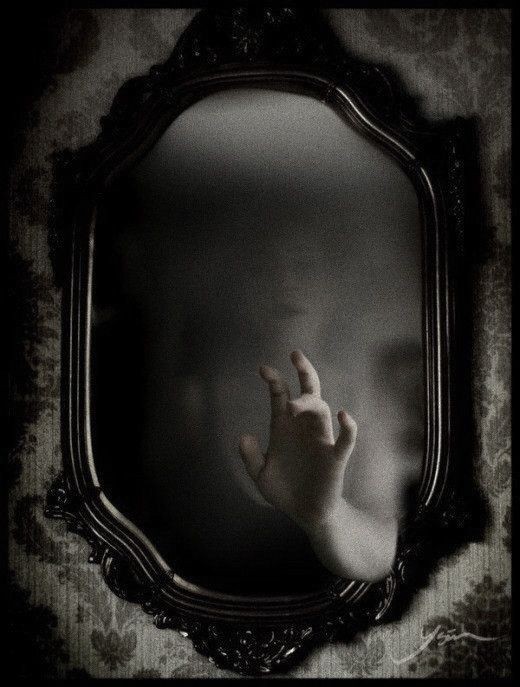
Banishing
Mirrors, as reflective surfaces and magickal conductors, are often used in banishing spells. Banishing magick can be used when someone is directing negative energy your way or you're being harassed. In this case, a mirror can be used to return bad energy back to the person who sent it.
Banishing magick can be a wonderful tool when applied to bad habits or negative thoughts as well. To banish an idea or behavior, encant something akin to: "[what you're banishing] you've caused me pain, I banish you, now stay away. Mirror help to reflect my plight, and keep [what you're banishing] out of sight". Keep the mirror close to you in order to protect you from what you're banishing.
Defense
Mirrors are also an incredibly effective defensive tool. They can deflect any negative energy, ill intent, or malevolent spirits sent your way. By placing mirrors in areas where you need the most protection, you can repel any unwanted energy trying to infiltrate your space. For added potentcy, draw a protective sigil/symbol on the mirror and/or place a protective crystal in front of it.

Hexenspiegal: The Witch's Mirror
A hexenspiegal is a small mirror used as a protective charm to reflect away baneful/attack magick, the evil eye, and other bad omens and intentions, as well as return the energy back to its sender. Its basis is in German folk magick. Translated, it means "witch's mirror". Hexenspiegals may be suspended from cords, fastened to walls, or, in the case of small ones, worn as jewelry. You can make your own by cleansing, decorating (optional), and sigifying/enchanting a small mirror to your intent.
#witch#magick#mirror#spell work#spellwork#spellcasting#spells#spell#folk witchcraft#folk magic#divination#scrying mirror#Scrying#spirit work#lefthandpath#dark#witchcraft#demons#satanic witch#demonolatry#eclectic witch#Pagan#witchblr#witch community
316 notes
·
View notes
Text
Bioregional Magic: Sustainable Ways to Work with Native Plants
Note: Post Contains Personal Anecdotes and UPG
As someone with a nature-based practice, I completely understand the desire to work with native plants. Many of us are deeply compelled to foster a connection with our land spirits and the local flora and fauna.
But with the normalization of consumption in witchcraft spaces paired with unethical wildcrafting and foraging practices, it's important to be careful. We don't want to harm the native plant populations and the wildlife that depends on them in our quest for a more localized practice.
Learning which plants are safe to harvest
By safe, I don't mean safe to handle or consume, though this is also crucial knowledge for anyone harvesting wild plants in general. I'm specifically referring to whether or not the collection of native plant matter will make a negative impact on the local ecosystem.
Think of it this way, if your practice is spirit-focused. Will the collective spirits of certain plants really want to assist you if you're devastating their population for your own gain? IME the answer is a hard no.
Take a look at a field guide and start identifying some of the native plants in your region. Are some of them listed as endangered, threatened, or special concern? Now you know which plants you should never disturb or collect materials from.
If not threatened, are some species generally harder to find? Are they present only in a certain type of environment? Do they take a long time to mature and/or have a very specific method of seed dispersal? Proceed with caution.
Example:
Common Blue Violets are one of the first plants to bloom in my garden during springtime. I also consider them very important in my practice and like to harvest them for certain rituals. But like I said, they're one of the first native plants to bloom during spring. Which means there are going to be pollinating insects, songbirds, and small mammals which rely on these plants for food. And predators who rely on those animals.
Since this is a hardy plant that usually grows in abundance, it's okay for me to harvest some from the garden for personal use. But I still need to leave enough to serve as a resource for wildlife and allow it to reproduce for the following year.
On the contrary, I never touch my wild Bloodroot. I only have two or three plants in the garden, their seeds have double dormancy germination requirements, and they take 2-3 years to reach blooming size. I have only ever collected seeds for propagation, and even then do it rarely because I know that the ants do a much better job at this than I could.
So when we can't harvest materials to use for tools and ingredients in workings, how do we utilize these plants in our practice?
Physical Representations and Symbolism
Images, objects, and symbols representing the plant can be used to substitute organic matter that you would otherwise collect and use for workings. Consider art pieces or photos, sculptures, sigils and seals, paper cut or folded into the shape of leaves or flowers, etc.
If the plant is your main component or energy source, consider designing the working to cater to this. For example, if I'm petitioning the spirit of milkweed, I might want to incorporate aspects of air and wind, since this is how their seeds are distributed. Or I may want to add some lunar energies knowing that this is the planetary correspondence for milkweed. This is would completely depend on my intent for the specific working and which physical or spiritual aspects of the plant I choose to work with.
If you're seeking a more long-term effect, try getting crafty and using symbols of the plant to decorate your own tools. I'm talking homemade oracle cards, painted jars or boxes for container spells, decorated offering bowls, ritual jewelry, and so on.
Working with Living Plants
This one is for the spirit workers. While it's entirely possible to petition plant spirits, especially collectives, solely using imagery, working carefully with a living plant can help establish a more direct spiritual connection.
This can be done by conducting your working outdoors, inviting the spirit of the plant into your space, and asking for assistance. During this time you would leave an offering, usually fresh water, but you can also offer things like soil or compost. Obtaining a working knowledge of certain plants can help inspire ideas for more creative, species-appropriate offerings, giving your spells and rituals an extra boost.
Now if this were a plant that was on a special concern or endangered species list, I would avoid offerings and actions that could potentially disturb the plant in any way. I may work within a few feet of the plant and present my offering in a bowl, removing it at the end of the working. I would definitely avoid touching it or say, pouring out water over the soil where it grows.
While we're on the subject of offerings, consider acts of service. Once again, we're going to use milkweed as an example. If I want to leave a nice offering for the spirit of milkweed and I know that Black Swallowtails feed on the nectar and pollinate it, I may offer a potted plant of dill placed in the wildflower garden. This is because Black Swallowtail caterpillars love to eat dill and will later pupate into adults, which will be beneficial for the plant. Consider different species and their relationship with each other. You may even get multiple spirit allies out of the deal.
Cultivation and Seed Distribution
Now, we've talked about ways to avoid harm when incorporating native plant species into our practices, but what about making a positive impact?
The Act of Growing Things is actually my favorite part of plant magic. Sure, I love harvesting my vegetables, fruit, and herbs to use in various recipes, and wild plants I find in the yard are excellent allies. But there really is something special about watching a tiny seedling grow into a full-sized plant, or seeing that delicate young native perennial thrive during its first year outdoors.
Whether transplanting or growing from seed, you're inevitably going to develop a strong relationship with that specific plant. You'll learn all about its growth rate, ecological benefits, soil requirements, and more. This will lead to folklore, correspondences, and later on your own UPG related to where this plant fits within your practice.
Another option, if you don't have the energy for more hands-on cultivation, is seed scattering. Disturbed areas like roadside ditches or even your backyard are perfect for this. Whether scattering or growing in starter pots, seeds can be charmed or enchanted with a specific intent and planted as a sort of living spell.
I use Prarie Moon Nursery for my seeds, but there are plenty of other affordable online vendors. You can also check out what's available locally. There are a few native-focused nurseries in my area that have a nice variety of options depending on the season.
#bioregional magic#plant magic#nature veneration#nature magic#spirit work#witchcraft community#witchcraft#witchblr
155 notes
·
View notes
Note
Hey! I just wanted to say that I’m a big fan of your blog and I love your posts about Dick Grayson <3
I must warn that english is not my first lenguage, therefore I apologize for any mistakes that I make.
I’ve seen some posts were you mention some things that I find very interesting, and I would love to have a longer analysis on them. For example, the dynamic between Slade/Deathstroke and Dick/Nightwing, how complex their relationship truly is and some similarities it has with Bruce’s and Dick’s relationship. I would love to read a longer post analyzing this and going into more detail about it, mainly because I’m also kind of new to getting to know much of their story (I’m also kind of new to the whole fandom in general hahah). I also found very interesting something you mentioned in one of your latest posts about Superman’s relationship with Dick, and how you found it a bit more complex than the one he has with Bruce, I would love to read more about that as well! Of course only if you have the time and actually want to do it, I don’t want it to sound as if I’m making any demands hahahah.
Thank you for your time! This is actually my first time asking anything to a blog, so I hope I did alright haha
Hello and THANK YOU SO MUCH!!! I would love to talk more about all of this with you!!!
For example, the dynamic between Slade/Deathstroke and Dick/Nightwing, how complex their relationship truly is and some similarities it has with Bruce’s and Dick’s relationship.
Anon's ask is based off this post where I discussed some similarities between Slade and Bruce in terms to their relationship with Dick but it wasn't really in depth.
In some ways I think Dick sees Bruce in Slade. I really don't know if Dick has made the connection between them but I think Dick is drawn to certain traits in Slade's and it subconscious at the least from his dealings with bruce. Meaning, Slade and Bruce have the same relationship with Dick as Dick has with the other. It's veiled because they're on opposite sides of the spectrum, but Dick and Slade's relationship have parallels with Dick and Bruce. We should really break this down lol.
I think the overarching component and similarity to each of their relationships with Dick, is that they see his potential to do better - to be better.
What do I mean by this - I mean that Slade and Bruce are similar in that they both see his potential and try to mold him into someone greater, but in different ways. The end result is that Bruce tests Dick's responsibility and pushes him further but still manipulative, while Slade's approach is more negatively manipulative and he tests Dick’s resilience and ethical boundaries.
So that's the first similarity - the praise and mentorship
Take a look at Slade's interactions with Dick and how he talks to him-
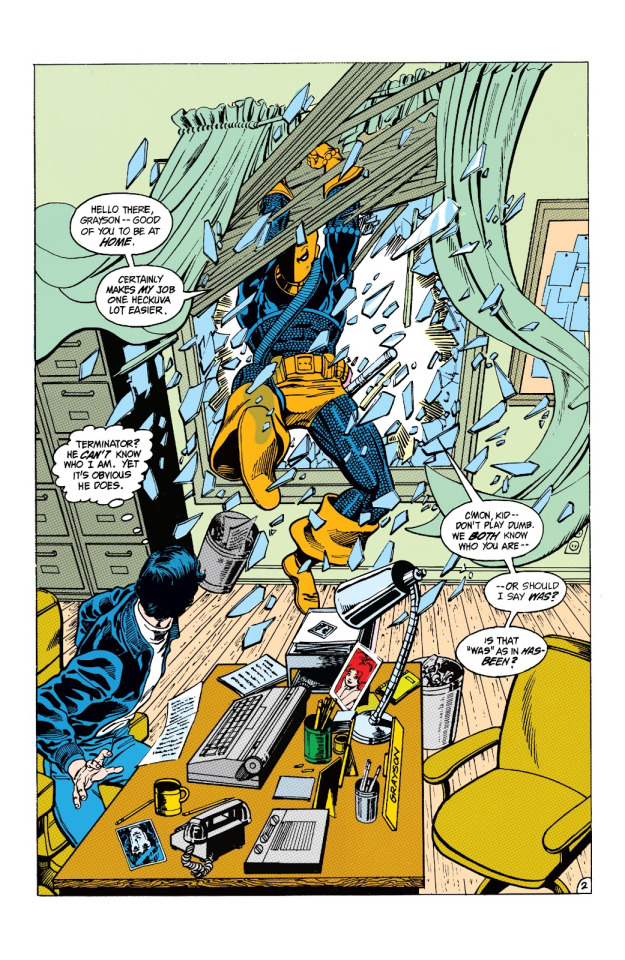

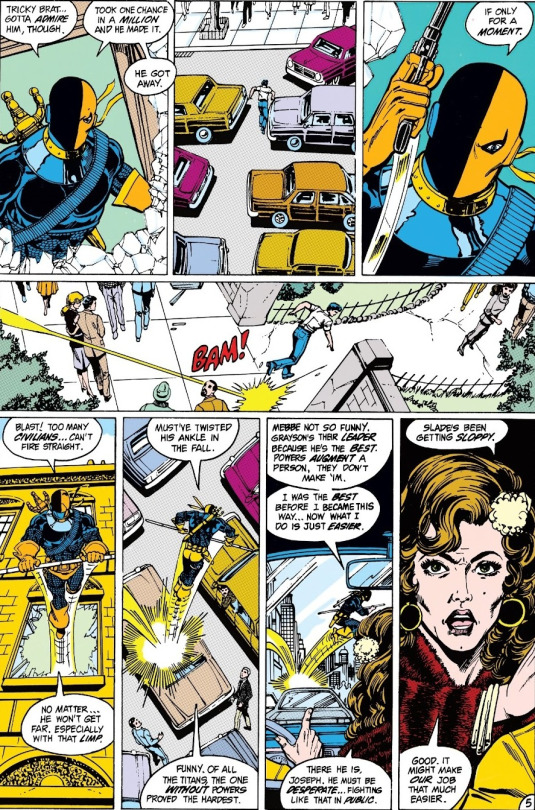
Tales of the Teen Titans Issue #43
He's effusive with his praise -
"You're not a fool, Grayson. Why are you pretending to be?'"
"Tricky brat...gotta admire him though. Took one chance in a million and he got away."
"Funny. Of all the titans, the one without powers proved the hardest."
The way they are to Dick, they are his consciousness. Slade is Dick's evil conscience and Bruce is his angelic conscience. (Their New Titans comics ally-ship was peak)
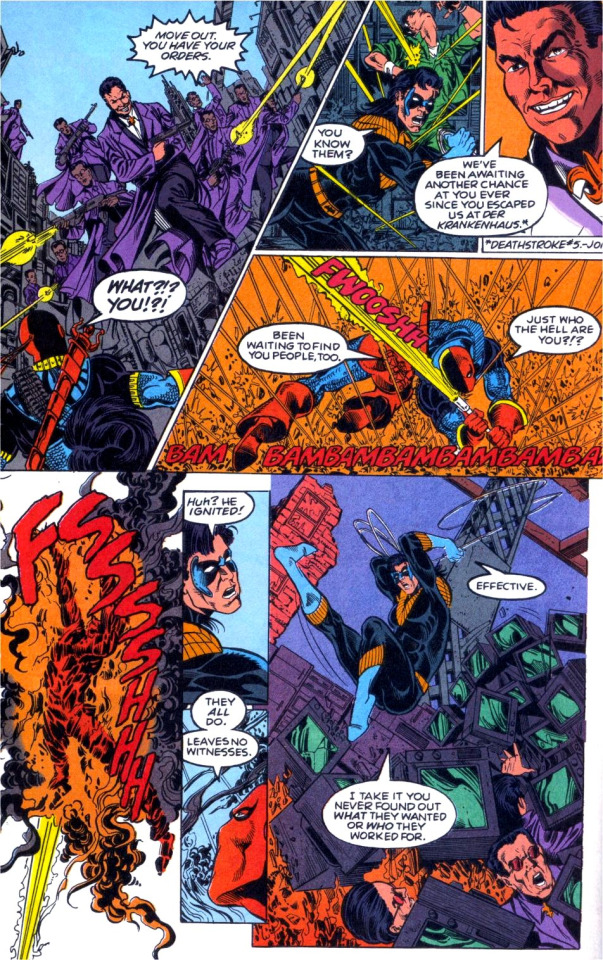

Deathstroke the Terminator Annual_1

Nightwing (1996) Issue #114

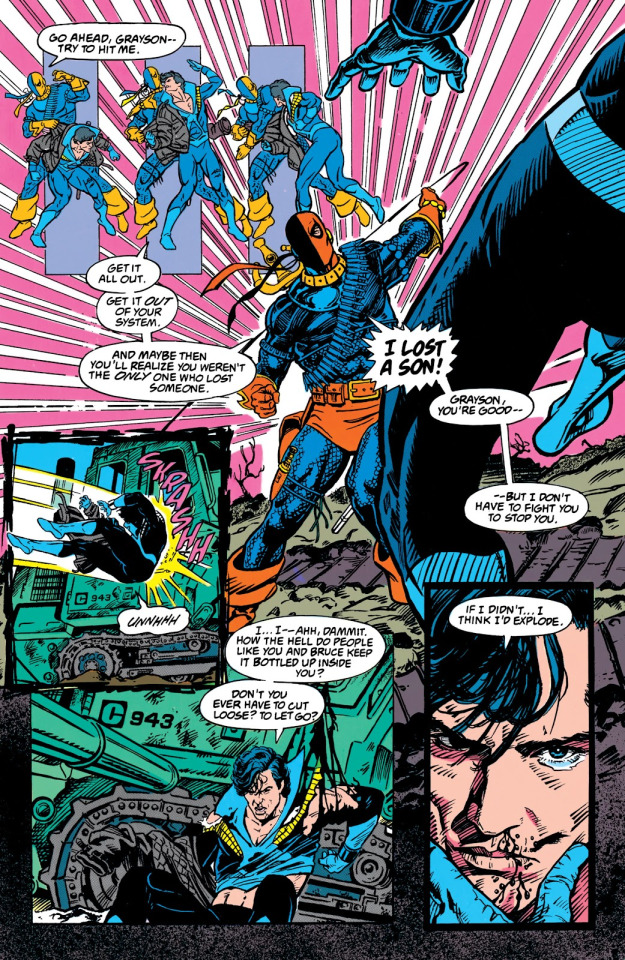
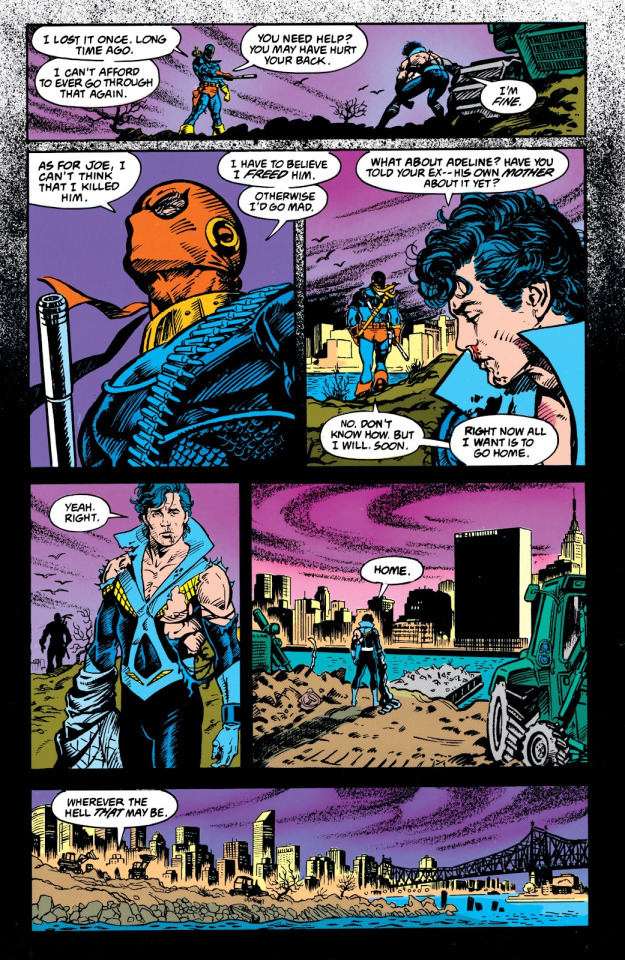
The New Titans (1988) Issue #86
They're nemesis, obviously, but Slade his this kind of tough love teaching going on with Dick. They're on opposite sides but he still makes him better. Dick, the hero he is now, is a consequence of the underlying teaching he learned from Slade. He's as supportive to Dick as he is ready to fight him with makes for a weird combo.
This kind of - I'll let you get your feelings out and then make you settle down - type of mentorship reminds me EXACTLY of Bruce's reaction to the Blockbuster event.
I think Dick is hooked to this type of relationship mainly because of his issues. Dick has canonical abandonment issues -
Now everyone's heard the term but what are abandonment issues?

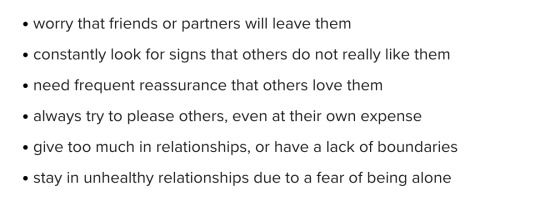
sounds reallyyyy familiar doesn't it?


Gotham Knights Issue #14
It's very definition is basically the entirety of Dick's monologue in Gotham Knights Issue 14.
Because of his abandonment issues, Dick is a huge people pleaser. There's a comic issue which I can't remember from where he's talking to i think Kori and Kori's like 'you've done enough. you're always there for everyone, it's more than enough. Why can't you be satisfied with that.' and Dick responds along the lines of 'It's ever enough.'
So Dick on a basal level is attracted to figures of authority. He feels both the need to earn praise from them yet this desire wars with his own need to be free of them. He has control issues on top of abandonment issues. There's a comic that I forgot the name of but Dick teams up with members of the Justice League and they trapeze through a jungle under the orders of this corrupt military general. He teams up with Arthur and automatically starts commanding people to which Aquaman tells him off, saying this isn't the Titans. Dick is genuinely sorry and backs off. For a minute. But immediately goes right back into command mode but Arthur lets it go, realizing that Dick's not conscious of it and that his behaviour is automatic. "Too many leaders" he calls the situation in his head.
He's wants his freedom and control and to be acknowledged for that freedom and control just as much as he wants to be acknowledged for following orders/being a good boy.
it's fucked up.
And this all ties back into Dick's relationship with Slade paralleling Dick's relationship with Bruce.
With Bruce, this thought process is very clear and it's okay for him to think about (because he'll never admit it out loud) it because it's his mentor/best friend/father.
Dick can not think this way about Slade because he is not supposed to. Slade is his enemy. But his actions talk more than this words which is why whenever Dick allies Slade, he acts like he does with Bruce. Or atleast, he feels that way.
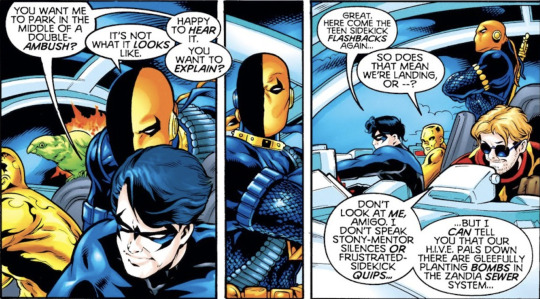
The Titans (1999) Issue #10
This is the time when their Dick's relationship with Bruce parallelling his with Slade is explicitly written. It's so obvious that even Roy picks up on it. Well, I shouldn't say 'even Roy' because Roy is pretty perceptive actually but the point still stands - it's obvious.
So in brief summary, Bruce and Slade's 'mentorship', if you can call Slade's as much, have parallels in their behavior and attitude towards Dick. And Dick, as a result of his issues, reacts the same way he does to Slade as he does to Bruce. Now this was all Dick's perspective of the situation, but the thing is, Bruce and Slade know Dick. They know him very well which leads to my third point.
The freaking parallel manipulation
It's so crazy how they act towards him. They both try to manipulate him -
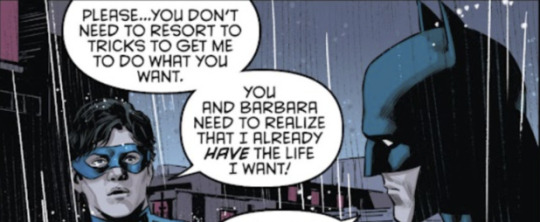
Nightwing (2016) Issue #75
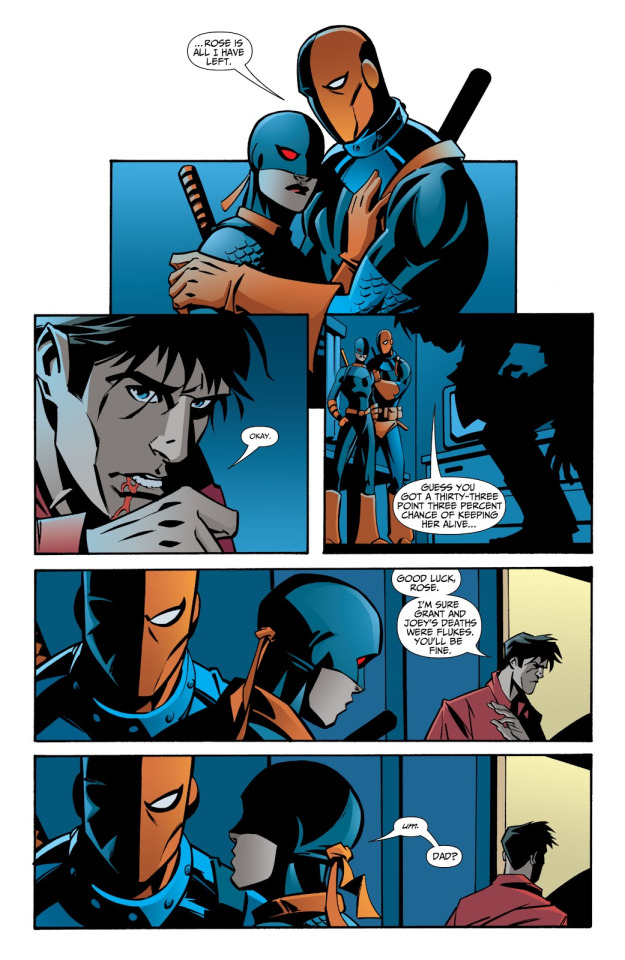
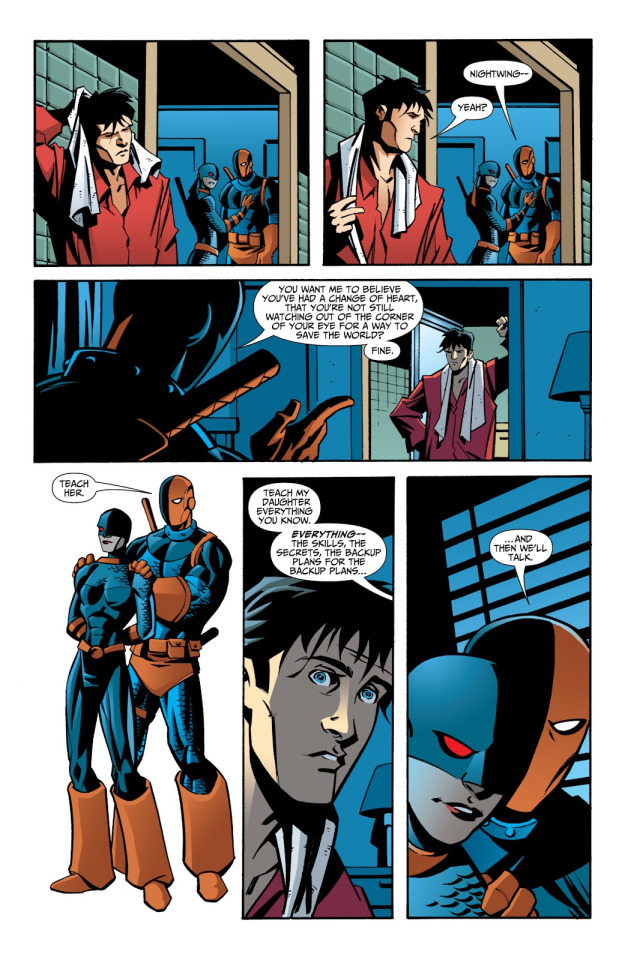
Nightwing (1996) Issue #112
But you what's really messed up in their similarity between these two scenes?
It's the fact that both Slade and Bruce are trying to manipulate Dick into coming back or staying with them.
Bruce using using Alfred's death and appealing to Dick's sense of guilt over staying separated from the family in order to coerce dick into coming back into Bruce's fold. This is what Dick means when he says he's sick of the mind games.
Slade, on the other hand, is appealing to Dick's sense of justice and moral righteousness. He's using his daughter in order bring Dick to his side by teasing Dick's need to do good for others. He's coercing Dick by hanging his daughter as bait on a hook and saying 'look. The naive daughter of an evil mercenary. Don't you want to save her?' He's targeting Dick's hero complex and need to protect the vulnerable.
This makes the parallels even more disturbing because both men are well aware of how to play Dick's emotional strings to pull Dick into their sphere and gain control over him.
In summary, there are three overarching components that make Dick and Slade's relationship eerily similar to Dick and Bruce's and vice versa.
With Bruce's relationship, his mentoring is rooted in emotional support but it often borders on manipulation. He sees Dick's potential and pushes him, sometimes excessively. Because of this push-pull relationship with bruce, Dick usually feels torn between adhering to loyalty and fighting for independence. His mindset is just perpetually caught in the middle which makes it so easy for Slade to exploit because Dick’s abandonment and control issues make him crave Bruce's approval while simultaneously feeling stifled by the overbearing nature of their bond.
Slade's relationship with Dick is darker, more manipulative, and rooted in exploitation. Although Slade is sometimes mentor-like, his intentions are really not. But the confusing thing is that's not always true. Sometimes he wants the best for dick and other times he's the worst enemy. He sees Dick's potential and uses it to manipulate him for his own purposes. While Bruce appeals to Dick's guilt, Slade appeals to Dick's sense of justice and heroism.
They both share a deep understanding of Dick’s potential and vulnerabilities. They know exactly how to manipulate him emotionally—Bruce through guilt and family ties, and Slade through exploiting Dick’s need to help others. Just like how both Slade and Bruce act the same way to Dick, Dick reacts the same way to both of them because he needs what they're selling.
Both Slade and Bruce see Dick as a tool to achieve their goals - Bruce shaping him to be a protector and leader, while Slade views him as a weapon in his own fight. Dick’s response to both figures is a reflection of his deep-seated need for approval and his desire for autonomy. This makes his relationships with Bruce and Slade sooo much fun to explore. Treating your enemy like you treat your friend? Hahaha!
I'll answer the Dick and Clark question in another post because I'll definitely exceed the image count per post if I try to answer it in this one.
And thank you again, anon!! you were perfect (*^ ‿ <*)♡
#dick grayson#nightwing#slade wilson#deathstroke#bruce wayne#batman#rose wilson#ravager#cl anon asks#cl asks#thanks for the ask!
148 notes
·
View notes
Note
I have another intense ask about bhaalist AU drow...
Would drow be “forced” to procreate? And how would Asatrion take that information? If Astarion is his consort, would he be jealous of concubines? Would this also contribute to his overall dissatisfaction during his time trapped at the bhaal temple? Or Would he be happy that his lover has distractions, so he can have time alone - maybe plotting his escape?
I’m overall curious about how drow and Astarion’s relationship falls apart in your AU
I don't think so! Not that I care about biblically following canon or anything like that, but there was nothing throughout the story that made me think procreation was a requirement in Bhaal's plan. If you take the scrapped ending into consideration, it seems to be more of a punishment first and foremost.
Not to say I don't believe it to be a part of the man-made gospel in some form or another. Sarevok seems fairly invested in this idea of generating bhaalspawn that are pure of blood, and this is an agenda that he subtly pushes onto DU drow throughout their years operating the temple: that said, like it often is, Bhaal is silent on the matter.
There seems to be a lot of conflict within the cult about what Bhaal wants and how he wants it, and I choose to interpret his failure to clarify as part of the Murder God's nature, as well as a fun nod at the (dys)functionality of real-life cults where you have several people claiming to have a direct connection to a god.
But back on topic, there IS the heavily implied Dark Urge To Multiply. A few instances where durge or someone around them suggests that, eventually, having children will be an irresistible biological necessity. There are a few ways to interpret this! But I can't help but notice that this theme is absent in a route where you do willingly become Bhaal's chosen - maybe its a failsafe Bhaal cooked into The Dark Urge in case his child became a weenie? To possess them with the need to spread their seed around until SOMEONE down the family tree stepped up to the role?
This definitely turns out to be the case in DU drow's redemned route, where he is plagued with bouts of breeding-related mania and depressive episodes that come and go as a result of a nest remaining empty, But I hadn't really considered this for his Bhaal-embracing self He definitely harbors an obsession with procreating in that AU - but... I'm not sure that's Bhaal's doing anymore. I think he just wants for there to: A) Be more of him around. B) Create a tangible, undeniable connection between himself and Astarion that cannot be severed.
A theme with DU drow is that he is aggressively monogamous. This remains constant in every possible iteration of him and it's a pillar of the character - he is devout to a partner until the end whether they want him or not, and so, Bhaalist DU drow would be violently opposed to the idea of being sexually involved with anyone besides Astarion. If Sceleritas or members of the temple insisted otherwise, he would balk and them push them off into a Chasm. If Bhaal demanded him do it, he would jerk off into a vial and hand it to whoever he deemed pretty enough to mix up with, and then probably kill the child as soon as it was born, anyway - because it's not right.
DU drow (again, in all iterations) almost believes there to be a magical component to true love that affects a person's life beyond just their choice in long-term partners. Just like he once decided that Orin was his forever-mate, he's now decided him and Astarion are intrinsically linked, that they are stronger together than they will ever be apart again. And It is particularly romantic to him (a matter of ironic fate, really) that the Murder Prince's true love would be undead. In DU drow's mind, and SPECIALLY in his Bhaal-embracing version, this is simply the universe's plan for him, and to divert from it in any way (by, for example, procreating with someone else) would be blasphemous.
Now, obviously him and Astarion can't have biological children for a plethora of reasons. But this is fantasy. Bhaalist DU drow would simply not stop until he found the best way to create someone that could be, spiritually and physically, considered their functional blood-offspring. Through Alchemy, magic, ritual, whatever it may be - as long as it works and works according to his high-standards. I suspect he would have specialists shipped in from wherever they may be in the realms to look into the issue, and probably someone who's sole job is to research the matter, though I'm not sure he would ever be satisfied with the results.
I think Astarion would be utterly checked out of the matter.
191 notes
·
View notes
Text
The Metaverse: A New Frontier in Digital Interaction

The concept of the metaverse has captivated the imagination of technologists, futurists, and businesses alike. Envisioned as a collective virtual shared space, the metaverse merges physical and digital realities, offering immersive experiences and unprecedented opportunities for interaction, commerce, and creativity. This article delves into the metaverse, its potential impact on various sectors, the technologies driving its development, and notable projects shaping this emerging landscape.
What is the Metaverse?
The metaverse is a digital universe that encompasses virtual and augmented reality, providing a persistent, shared, and interactive online environment. In the metaverse, users can create avatars, interact with others, attend virtual events, own virtual property, and engage in economic activities. Unlike traditional online experiences, the metaverse aims to replicate and enhance the real world, offering seamless integration of the physical and digital realms.
Key Components of the Metaverse
Virtual Worlds: Virtual worlds are digital environments where users can explore, interact, and create. Platforms like Decentraland, Sandbox, and VRChat offer expansive virtual spaces where users can build, socialize, and participate in various activities.
Augmented Reality (AR): AR overlays digital information onto the real world, enhancing user experiences through devices like smartphones and AR glasses. Examples include Pokémon GO and AR navigation apps that blend digital content with physical surroundings.
Virtual Reality (VR): VR provides immersive experiences through headsets that transport users to fully digital environments. Companies like Oculus, HTC Vive, and Sony PlayStation VR are leading the way in developing advanced VR hardware and software.
Blockchain Technology: Blockchain plays a crucial role in the metaverse by enabling decentralized ownership, digital scarcity, and secure transactions. NFTs (Non-Fungible Tokens) and cryptocurrencies are integral to the metaverse economy, allowing users to buy, sell, and trade virtual assets.
Digital Economy: The metaverse features a robust digital economy where users can earn, spend, and invest in virtual goods and services. Virtual real estate, digital art, and in-game items are examples of assets that hold real-world value within the metaverse.
Potential Impact of the Metaverse
Social Interaction: The metaverse offers new ways for people to connect and interact, transcending geographical boundaries. Virtual events, social spaces, and collaborative environments provide opportunities for meaningful engagement and community building.
Entertainment and Gaming: The entertainment and gaming industries are poised to benefit significantly from the metaverse. Immersive games, virtual concerts, and interactive storytelling experiences offer new dimensions of engagement and creativity.
Education and Training: The metaverse has the potential to revolutionize education and training by providing immersive, interactive learning environments. Virtual classrooms, simulations, and collaborative projects can enhance educational outcomes and accessibility.
Commerce and Retail: Virtual shopping experiences and digital marketplaces enable businesses to reach global audiences in innovative ways. Brands can create virtual storefronts, offer unique digital products, and engage customers through immersive experiences.
Work and Collaboration: The metaverse can transform the future of work by providing virtual offices, meeting spaces, and collaborative tools. Remote work and global collaboration become more seamless and engaging in a fully digital environment.
Technologies Driving the Metaverse
5G Connectivity: High-speed, low-latency 5G networks are essential for delivering seamless and responsive metaverse experiences. Enhanced connectivity enables real-time interactions and high-quality streaming of immersive content.
Advanced Graphics and Computing: Powerful graphics processing units (GPUs) and cloud computing resources are crucial for rendering detailed virtual environments and supporting large-scale metaverse platforms.
Artificial Intelligence (AI): AI enhances the metaverse by enabling realistic avatars, intelligent virtual assistants, and dynamic content generation. AI-driven algorithms can personalize experiences and optimize virtual interactions.
Wearable Technology: Wearable devices, such as VR headsets, AR glasses, and haptic feedback suits, provide users with immersive and interactive experiences. Advancements in wearable technology are critical for enhancing the metaverse experience.
Notable Metaverse Projects
Decentraland: Decentraland is a decentralized virtual world where users can buy, sell, and develop virtual real estate as NFTs. The platform offers a wide range of experiences, from gaming and socializing to virtual commerce and education.
Sandbox: Sandbox is a virtual world that allows users to create, own, and monetize their gaming experiences using blockchain technology. The platform's user-generated content and virtual real estate model have attracted a vibrant community of creators and players.
Facebook's Meta: Facebook's rebranding to Meta underscores its commitment to building the metaverse. Meta aims to create interconnected virtual spaces for social interaction, work, and entertainment, leveraging its existing social media infrastructure.
Roblox: Roblox is an online platform that enables users to create and play games developed by other users. With its extensive user-generated content and virtual economy, Roblox exemplifies the potential of the metaverse in gaming and social interaction.
Sexy Meme Coin (SEXXXY): Sexy Meme Coin integrates metaverse elements by offering a decentralized marketplace for buying, selling, and trading memes as NFTs. This unique approach combines humor, creativity, and digital ownership, adding a distinct flavor to the metaverse landscape. Learn more about Sexy Meme Coin at Sexy Meme Coin.
The Future of the Metaverse
The metaverse is still in its early stages, but its potential to reshape digital interaction is immense. As technology advances and more industries explore its possibilities, the metaverse is likely to become an integral part of our daily lives. Collaboration between technology providers, content creators, and businesses will drive the development of the metaverse, creating new opportunities for innovation and growth.
Conclusion
The metaverse represents a new frontier in digital interaction, offering immersive and interconnected experiences that bridge the physical and digital worlds. With its potential to transform social interaction, entertainment, education, commerce, and work, the metaverse is poised to revolutionize various aspects of our lives. Notable projects like Decentraland, Sandbox, Meta, Roblox, and Sexy Meme Coin are at the forefront of this transformation, showcasing the diverse possibilities within this emerging digital universe.
For those interested in the playful and innovative side of the metaverse, Sexy Meme Coin offers a unique and entertaining platform. Visit Sexy Meme Coin to explore this exciting project and join the community.
274 notes
·
View notes
Text
The -go Verbs
When you're learning the present tense, there's a subset of verbs that are commonly called the -go verbs, because the present tense yo form ends in -go
The verbs in question are usually one of two things: just plain irregular, or regular except for that particular conjugation
The -go verbs include:
tener "to have" -> tengo
hacer "to do/make" -> hago
decir "to say" -> digo
poner "to put" -> pongo
venir "to come" -> vengo
salir "to leave/exit" -> salgo
valer "to be worth" -> valgo
oír "to hear" -> oigo
caer "to fall" -> caigo
traer "to bring" -> traigo
These will also apply to the majority of verbs that are connected to them
-
satisfacer "to satisfy" -> satisfago
componer "to compose" -> compongo
bendecir "to bless" -> bendigo
maldecir "to curse" -> maldigo
prevenir "to prevent" -> prevengo
sobresalir "to stand out/to exceed" -> sobresalgo
atraer "to attract" -> atraigo
And so on
-
These are important to keep in mind for two reasons.
First is eventually when you get to present subjunctive; present subjunctive takes its conjugations from the present tense yo forms
As an example, if decir goes to digo, then you'll notice that present subjunctive looks like diga, digas, diga, digan, digamos
You'll also see some of this for commands, but that's a whole other topic with its own host of weirdness all its own...
The second thing is that many of these verbs will have an irregularity in the future and conditional tenses; not all of them, but enough to be aware of
As an example, tener goes to tengo... but then in future it would be tendré "I will have" and then conditional tendría "I would have / I could have"
...You'll find that the irregularities in future and conditional often come with a D, R, or RR [as an example saldría, haría, querría]
Future and conditional share the odd conjugation patterns but the ending is different; pondré/pondría, haré/haría, diré/diría etc
All of that to say is for present subjunctive if it's irregular in the yo that's the pattern you follow
...and future/conditional tends to take its irregularities from the -go verbs [but not always, as querer is irregular there and there are some others, but in general the -go verbs tend to be a small subset because of expected weirdness]
-
*Small Side Note: There's also one other verb to note technically that is also a -go verb. That is asir which goes to asgo. The verb asir is "to grab/seize" but it's highly unlikely that you'll use it or see it. There are some contexts where you'll see el asa (technically feminine) or el asidero meaning "handle" or more literally "place to grab"... but you almost never see asir in regular usage.
Predominantly if you're saying "to grab/hold onto" you are either using agarrar or aferrar, or in some countries like Spain it's coger
[but be careful about using coger, because in some countries that's quite a vulgar verb for "to fuck"]
I only mention asir because if you look up the -go verbs, they will mention asir but it's not the common verb used for what it means. It's included on the list of -go verbs, and that's usually where people will see it the most. To be clear - outside of the verb list, I can't say I've seen or heard asir used in common Spanish because there are just so many more common verbs to use
210 notes
·
View notes
Text
An Idiot's Guide to Creating Themes
There's something that Wildbow says about themes, which I'll paraphrase here: themes are something that grow without you even necessarily wanting them to, so long as the characters have strong traits and act consistently.
What this means is that if you have a character who has a real problem with authority, then naturally they're going to frame a lot of things through the lens of authority, and they're naturally going to get in conflicts with people in a position of authority. Suddenly, without even really trying to, you have created a Theme.
I don't really think that this by itself is enough, and think that it helps to bring some intentionality to the process. For one thing, if you have two protagonists who have their own strong traits, you might develop two different competing themes that do not work in harmony with each other, and suddenly people will start asking you "why isn't this two separate stories" and you'll come to the grim realization that they're right.
So if you have a single strong trait, you want to pick your other traits to be in harmony, and you want to do the same when you're thinking up secondary characters, villains, etc. Themes tend to flow a lot easier if all the stuff you're putting into the pot has something that links them together. Ideally you want a funhouse mirror where you get to see a bunch of different sides of your theme, different ways that the characters react to it, their different takes on it, even if you're just doing big shonen battles.
Doing theme construction in this way often involves trying to have the story as a prism, and your job as someone writing the story is to break that beam of light down into its component parts. Find as many pieces as you can, then make those into plot points, characters, side stories, etc.
Let's try an example!
I'm writing a superhero story and want to pick a theme, so first I think about what theme I want to spend a novel exploring, and I decide that the idea that's tickling me is the alienation of globalization and the information age, the way that everything feels overwhelming and Too Big sometimes, like there are a thousand things clawing at me for my attention.
So we start with our protagonist, and he's being pulled in a thousand directions at once, never feeling like he has enough time for anything, but paradoxically, for all that people want his attention and focus, he also feels alone. I haven't yet said that he's a superhero, but sure, it's easy to see how we can fit that in: people want him to solve their problems, to settle their disputes, to use his talents, to help them rise through the ranks, and that's not necessarily what he wants, but he feels trapped by it, like there's no other way to live.
If he's a superhero, he needs a superpower, and writing a story like this I would be extremely careful with what I picked since it needs to help carry many many fight scenes and plot points, but teleportation is my first thought: there's disorientation as he enters a new place, a feeling that he's never really anywhere because he could be everywhere, and maybe some secondary sensory powers on top of that, an ability to see and hear that can help evoke an internet connection (I have not at this point decided whether the setting has smartphones or internet, but I think maybe it works better if it doesn't, because one of the things about themes is that sometimes it's best to come at them from an angle).
So I kind of have a sense of the main character at this point, if not an overall plot. If the guiding star is "information age alienation and how it overwhelms us, offering infinite connection that leaves us lonely", then maybe the plot can be something about that. We can go toward the theme by having some plot about alienation, a society that's drifting apart, and probably a significant figure pushing that, or we can go toward the theme from a different direction, having someone who promises an answer. I like the promise of an answer better, something that our hero has tension against, so we whip up a villain whose whole thing is that the world has gotten too varied, too complicated, and promises a return to simpler times. Maybe they're a cult leader, promising family, promising that through their high-control group everything can be reduced down to something understandable.
(There are at this point many many options for our main villain and his/her powers. Maybe it's a woman who makes the world go still and silent in her wake. Maybe it's a time-traveler acting as a specter of the past. Maybe it's someone with mind control powers seeking to expand their reach until they can put the whole city under their thumb. Maybe they're a former superhero who couldn't take the constant desires and demands of the public and have twisted into a dirty form of self-induldgence. There are many "villain" answers to the question of alienation.)
So we add in some side characters. They should also approach our theme in some way. Here's a quick and dirty brainstorming list:
A friend who is terminally cape-brained, always keeping track of their specific domain of expertise, retreating hard into a niche where they know everything, which takes monumental effort and a sort of nervous anxiety approach to information. Probably a superhero with an info power, name of Dispatch or something.
A father who is blissfully unaware, but shows the flaws of that approach, always ignorant, knowing little about the goings on of the greater world, alienated in his own way by that, unable to connect to people because of it.
A government handler/contact who is a friend, but always pushing our hero, always ready with another thing that needs doing, another cause that needs nudging, a criminal manhunt to help with. A symbol of pressure, anxiety, and overload, but friendly in a way that makes it tough to say no. (A stand-in for the kind of friend who always wants to tell you about the latest atrocity, who doesn't quite demand that you know the name of every person brutalized by the police, or the latest list of people whose shittery has come to light, but does seem mildly disappointed that you're not as tuned in.)
A mentor figure who burned out, maybe a speedster who ran too fast, did too much, let themselves get run into the ground both figuratively and literally.
I think that this is a good enough starting point that if I wanted to writing this story, I probably could, and maybe the core of it would evolve as I wrote, but I have a guiding star to look toward, and one of the great things about setting out to write a theme is that if you ever hit a bump, you can look over at the post-it note that describes the theme in a few words and hopefully, get back on track.
174 notes
·
View notes